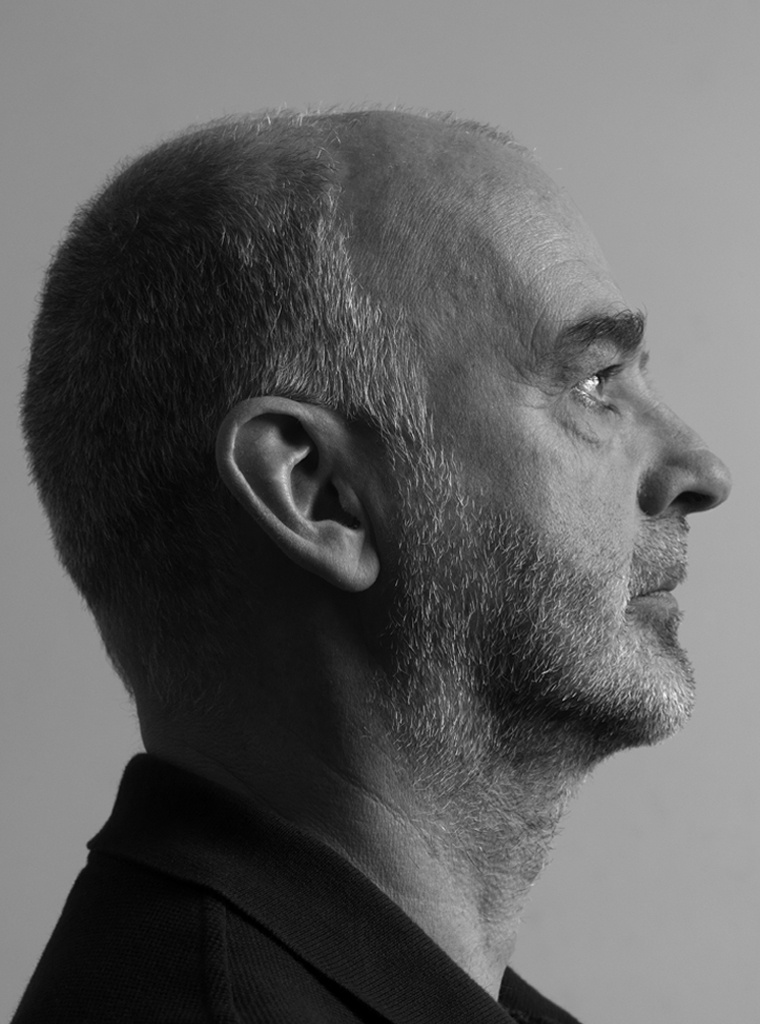Robert van Rixtel is the moving spirit of many publications and projects dealing with design and designers. In 1992, the first of a series of [Z]OO calendars was published, an initiative of Robert van Rixtel and Eric van Casteren, two young designers who had met at the academy for industrial design AIVE, now called Design Academy Eindhoven. [Z]OO stands for ‘[Z]Onderlinge Ontwerpers’, a Dutch wordplay on ‘associated’ and ‘oddball’. It has developed into a one-of-a-kind publishing house with a unique way of handling things. Many designers, photographers, writers, printers and paper producers supported the productions that followed [Z]OO’s first calendar, often without claiming any fee or expenses. Over time, [Z]OO has managed to create an impressive catalog of publications about graphic design as well as visual art, architecture, literature, exhibition design and design history.
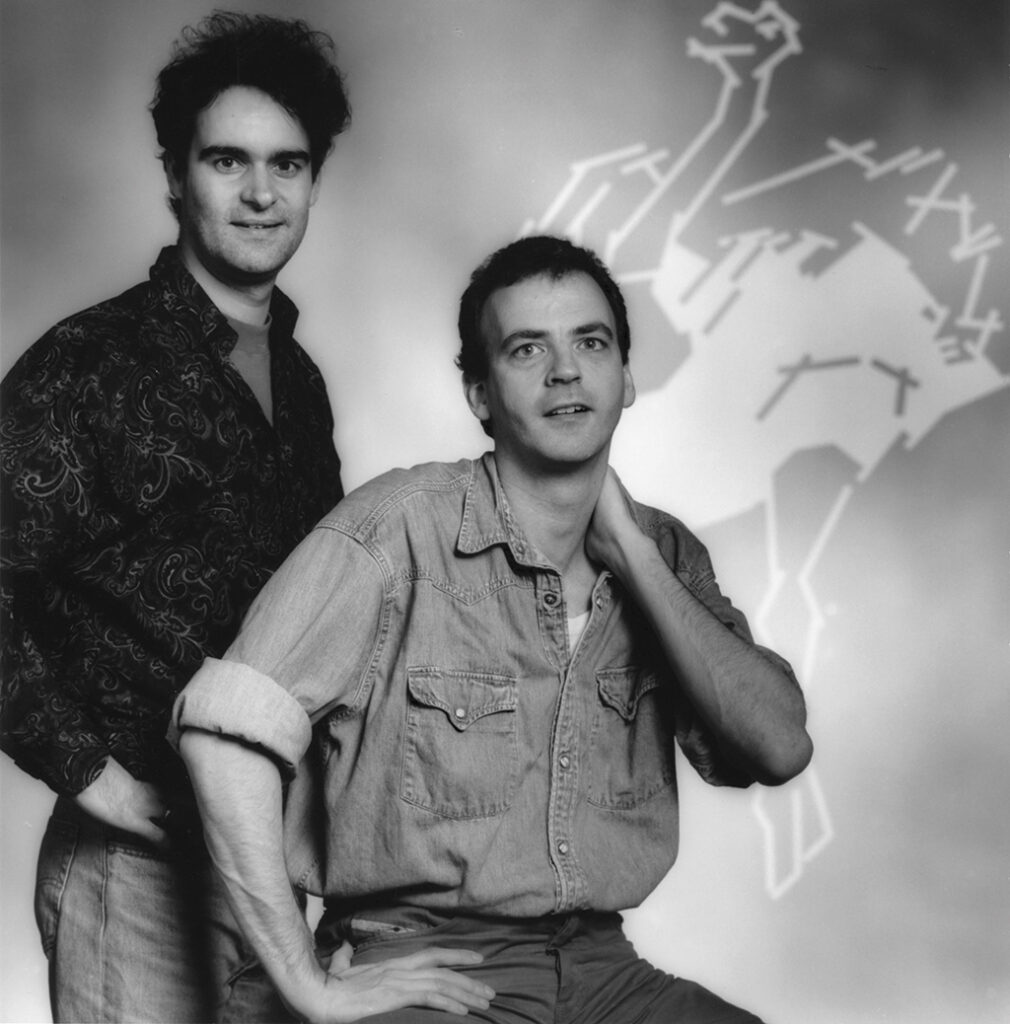
Eric van Casteren and Robert van Rixtel, founding of [Z]OO productions, 1992
Three months before his highschool graduation Robert van Rixtel was in a bit of a panick. He had no clue about what to do after finishing school. His dean advised him to take a career test. He did, and it gave him a choice: either park ranger or artist. A psychological test at AIVE decided he would be a perfect candidate for the design profession. That’s how everything started. An internship (during his third year at AIVE) opened his eyes. Rokus van Blokland’s class in the methodology of design was also very formative. In 1984, he graduated top-of-class at age 23; one of his graduation projects was a card game for blind and partially sighted people.
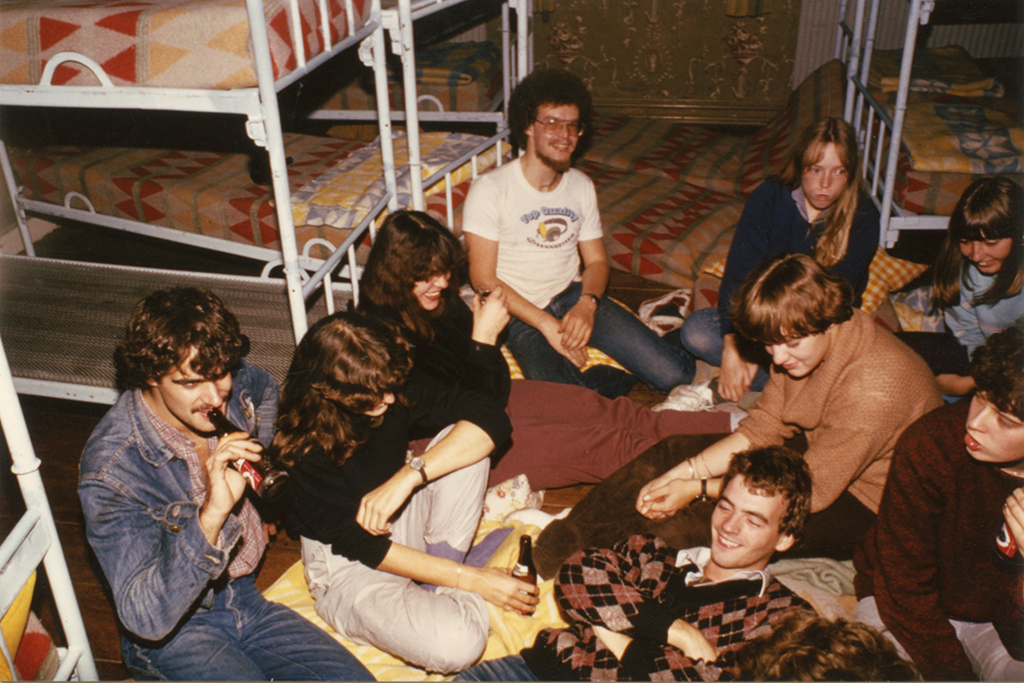
AIVE fourth year, 1982, with Eric van Casteren (jeans jacket), Joep Geelen (white T-shirt) and with Robert van Rixtel (stretched out in front)
Quixotic
In the same year, Robert’s co-student Joep Geelen graduated with as one of his projects a desk calendar (its theme: design), which he wanted to publish and sell. Joep started the publishing company Quixotic to offer co-student Erik Hoebergen a job that would keep him out of the conscription (being ‘essential’ for the company’s survival). Robert and Eric were asked to join; they accepted. Layouts of the calendar had to be produced; a printer had to be found. They had to plunder their saving accounts to get it printed.
The publication was praised in the then leading high-end magazine Avenue and became a success. Joep Geelen was the most commercial thinker and doer of the group and traveled all over Holland to distribute the calendars. The next year and the next they received larger orders, but each year again they had to contribute money coming from their own pockets. The calendars were so complicated that they had to be put together manually. Much time was also spent on beer-drenched conferences during which no decisions were reached or after which nothing was set in motion. “That’s the problem with working in a group. To get somewhere, you need one person to make the decisions,” Robert says in hindsight. After four years they managed to get a grant, but after seven years Robert and Eric decided to no longer participate in Joep’s dreams and chase their own. It was 1990.
Career
After graduating from AIVE, there was no doubt in Robert’s mind about entering the graphic design profession. But first he wanted to spend a few more years studying. He was accepted at the Royal College of Art, but he lacked the money to live and study in London. He decided to search for a grant, meanwhile accumulating experience. He approached Jan Lucassen (formerly of Tel Design), the newly appointed AIVE director, who suggested he’d apply for an internship at Concepts, 2D3D or Sdu (the government printer and publisher).
Concepts, in Amsterdam, was a young studio run by experienced designers. Two of their partners, Will de l’Ecluse and Hartmut Kowalke, invited Robert to have a beer with them and by the end of the afternoon Robert knew he had been accepted for a six-month internship. Concepts (other partners were Hans Bockting, Theo Groothuizen, Ton Haak, Ton Haas, Floor Kamphorst, Anne Stienstra and Marcel Vroom) had just acquired a new client: Ahrend (office furniture), and they were commissioned to produce eighty brochures within a period of one year. They asked Robert to extend his internship. Only later he realized how much of a breeding ground Concept was; working there, mostly assisting Hans Bockting, was of great influence to his own design career.
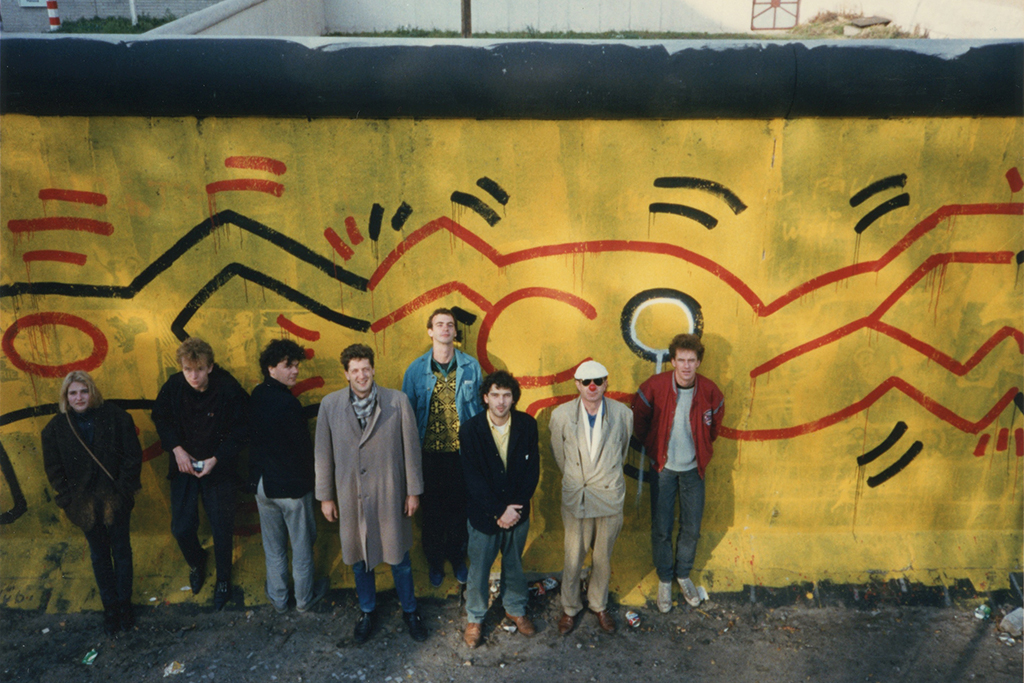
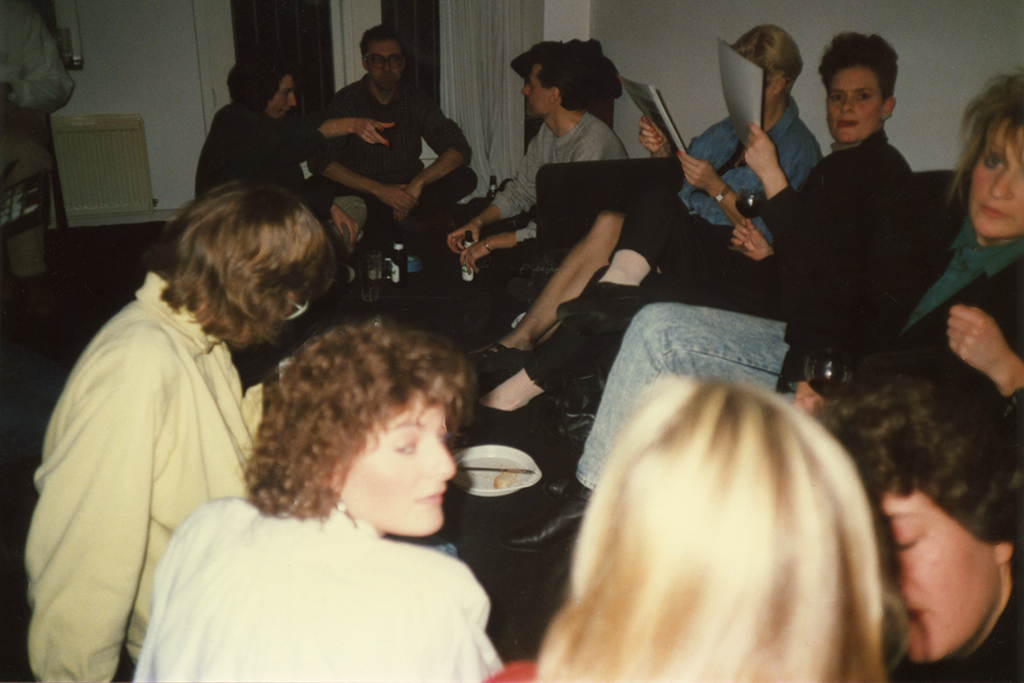
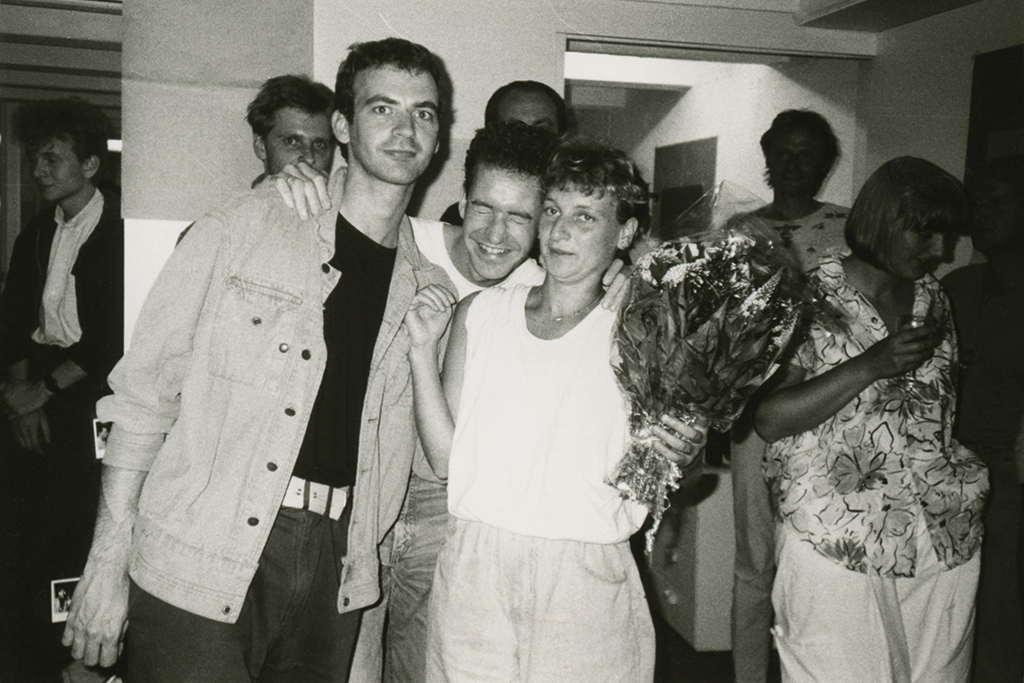
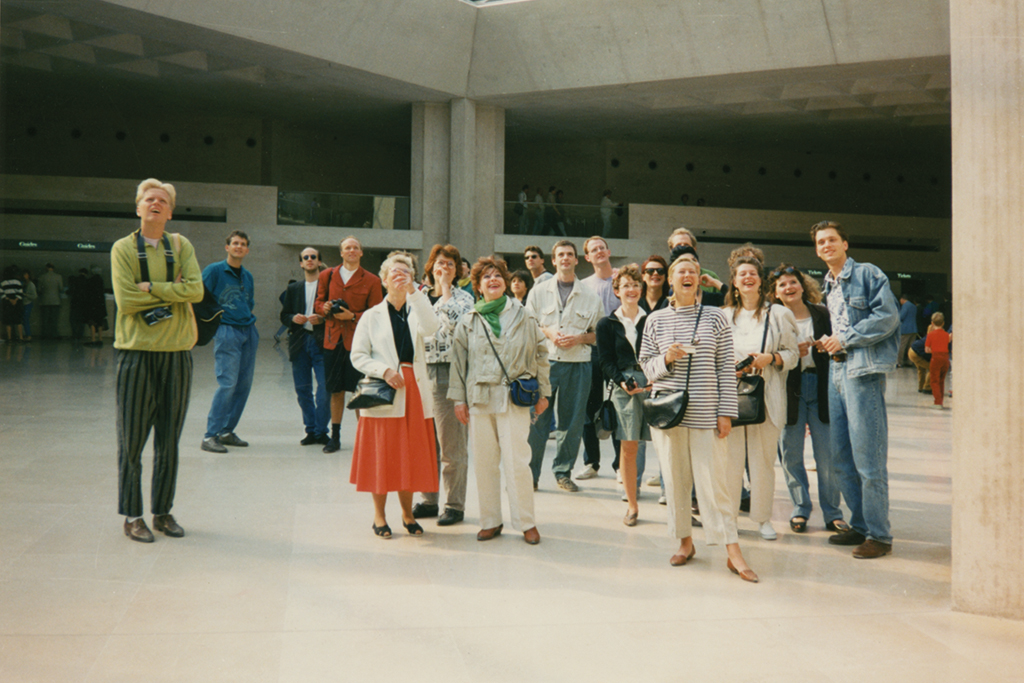
Design studios Amsterdam
Concepts 1984-1986 (visiting Berlin, 1986; farewell party, 1986) / Total Design 1986-1988 (dinner at Robert’s, 1987) / Dedato 1988-1992 (visiting Paris, 1990)
Later, he decided to apply for a job at Total Design – he followed his intuition, as he would continue to do when facing major decisions. He had to show his work to a TD jury group consisting of Daphne Duijvelshoff, Joost Klinkenberg, Marcel Speller and Wim Verboven, who all appeared to like his work. At the closure of the meeting, Daphne asked Robert about his interest in culture and after he had responded by telling that he never missed the weekly Studio Sport broadcast on TV, everyone had a good laugh and he was welcomed to join the team. In August 1986 he started as an assistant to Jelle van der Toorn Vrijthof. “They had me work with the Aesthedes computer, the first generation of design computers. It was before the Apple Macintosh reached the market.”
Total Design had moved from its original location on Herengracht to a warehouse at Van Diemenstraat, also in Amsterdam. “I thought a little action was needed and I invited the whole TD team, about thirty head strong, to have dinner at my place on the condition that everyone who showed up would eventually invite me to dinner at their place. These gatherings became interesting happenings.”
Haute Cuisine from the Lowlands
In 1987, several Dutch museums participated in a series of exhibitions titled ‘Holland in Vorm’ (Holland in form), which presented Dutch design from 1945 to 1987; the occasion was the international congress Design ’87 in Amsterdam. Concepts had designed the identity program. Robert took the initiative to assemble a group of young designers to produce, in collaboration with Xandra van der Swan, a goodwill publication called Haute Cuisine from the Lowlands. Congress organizers QLT would finance the publication, but they withdrew their offer “because of too few registrations”. However, many had started to work on the project already. Robert: “What to do? Stop everything, which you can do only once, or continue to look for a solution. Then I met Cor Rosbeek, the printer.”
Rosbeek suggested that Robert try and get the support of several printers and convince each of them to produce a section of the publication. Robert managed to get Ando, Equipage, Mart. Spruijt, Rosbeek, Spinhex as well as Sdu behind the plan. A group of forty young designers were put to work. For typesetting and lithography too, sponsors were found. A large box sleeve, LP format, contained individual recipe cards that surprised congress participants and introduced them to traditional Dutch dishes such as ‘Brabants konijn’ (rabbit), herring salad, ‘Arnhemse meisjes’ (cookies) and ‘hutspot’ (stew).
Everything got printed. But the cards had to be collected before they could be put into the sleeves. On a Saturday, Robert assembled all designers involved at NAP’s studio in Amsterdam to do the job. “In the end, I delivered everything at the congress hall myself. I was exhausted. I was sitting down on a bench to rest a little when I noticed how a congress visitor left the hall, failed to fit the box into his attaché case, and decided to solve the problem by taking all cards out, throw the box away, and fold the cards until they fit. At such a moment you realize how relative everything is.”
This happened before [Z]OO productions was founded. Still this publication is emblematic for the way Robert and Eric organize their projects, making good use of their networks and working with dogged perseverence. Sleepless nights were part of the deal, especially when unexpectedly a donation of paper or another promised collaboration fell through.
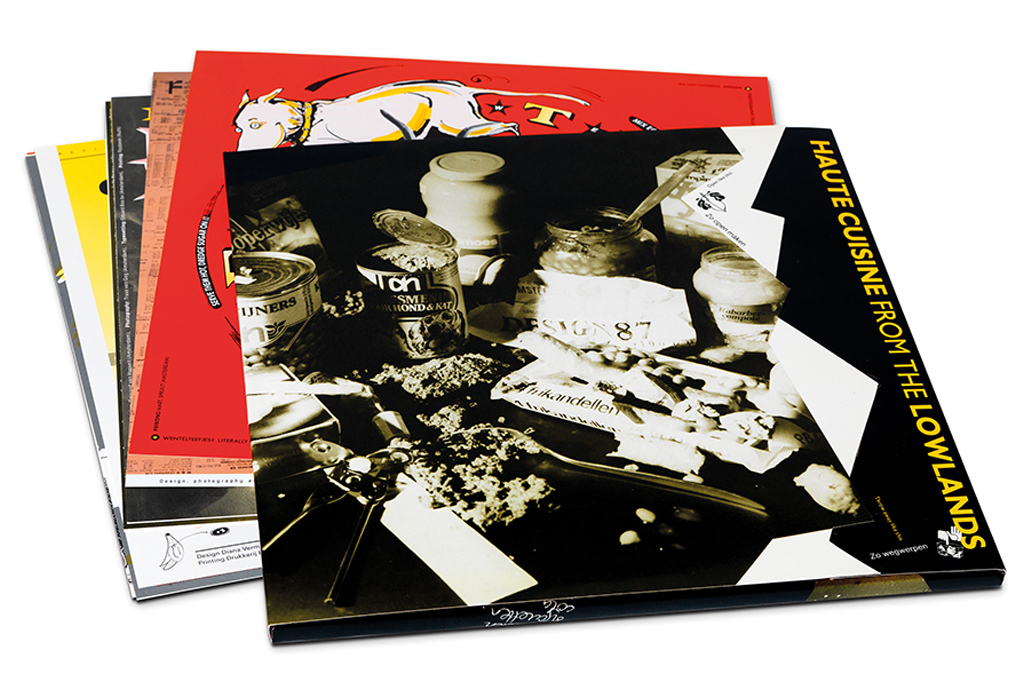
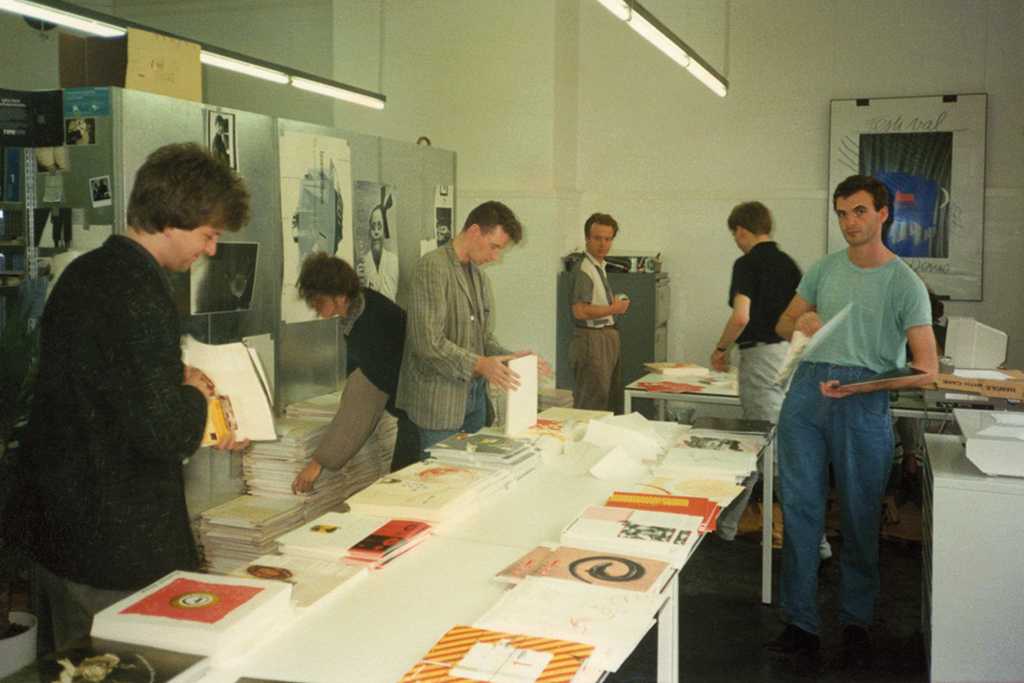
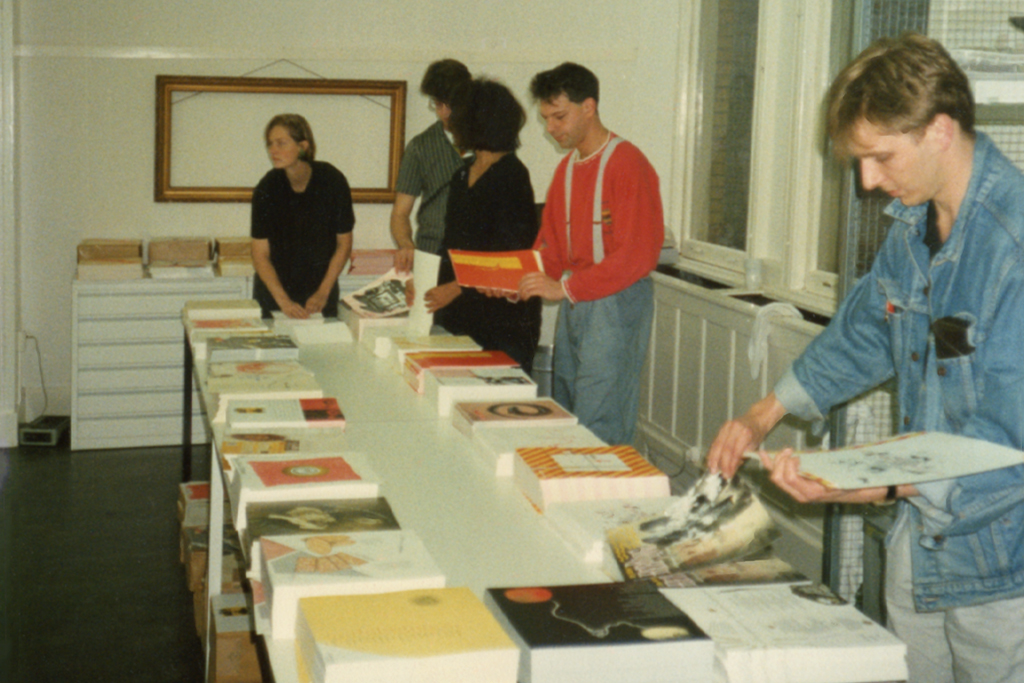
Haute Cuisine from the Lowlands
Design ’87, RAI, Amsterdam, August 1987
With John den Besten, Wouter Botman, Rosemarie van Boxtel, Ton van Bragt, Vincent Bus, Eric van Casteren, Gijsbert Dijker, Peer Dobbelsteen, Henny van Eck, Ben Faydherbe, Ton van Gastel, Joep Geelen, Denise Gehring, Reinoud van Hasselt, Jan Kees Karelse, Cook Koudenhove, Victor de Leeuw, Frans Lieshout, Hans Lodewijkx, Jean Paul Mombers, Ris van Overeem, Adth van Ooyen, Annette Raven, Lex Reitsma, Robert van Rixtel, Michiel Schriever, Xandra van der Swan, Harrie Verdijk, Hans Verlaat, Chris Vermaas, Diana Vermetten, Ine de Vries, Wout de Vringer, Olga IJspeert, Fred van der Zee and Marja Zuurman.
Print: Ando, Equipage, Mart. Spruijt, Rosbeek, Spinhex, Staatsdrukkerij
Plaza
After Total Design came Dedato, the studio founded by designer Henk de Vries. Robert stayed there for five years before he understood that the time was there to meet a new challenge. In 1993, pushed by his old co-student Wouter van der Schans, Robert van Rixtel with Goof Rutten started Plaza Ontwerpers (designers) in Eindhoven. By then, just after the end of the economy crisis, they were both in their thirties. Robert kept on his home in Amsterdam and commuted to Eindhoven. “We grew and grew. At one time we had a staff of five.”
Design Academy
Jan van Duppen was a board member of what was soon to be named Design Academy Eindhoven. In 1994, he asked Robert to teach to fourth-year and fifth-year evening class. Robert remained connected to the academy until 2003. One of his students was Juultje van der Put; she graduated in 1997 and as a freelance designer worked for De Cultuurfabriek and Oilily. They met again a year later in Amsterdam and became a couple. In 2001 they moved to Eindhoven.
After ten years of Plaza, Robert was ready to enter a new career phase. His partner, Goof, had dreams about making big money and driving a Porsche. Robert, though, wanted to create wonderful and interesting books. “I was, and still am, very proud of some of the identity programs I designed, but I needed more.” He took a long hike to clear his mind and reach a decision, which was: to realize at least two of his own projects a year. And that’s how it went ever since.
vanRixtelvanderPut Ontwerpers
2003. Robert and Juultje founded their own studio: vanRixtelvanderPut Ontwerpers. They worked from their home in Eindhoven where they also had to raise their two kids, Hanna and Huub. Juultje is the one who adds stability to the studio; she contributes actively to all projects, throughout all phases and processes, and she also acts as Robert’s help desk at the moments digital problems have to be solved. Their clients include: Eindhoven University of Technology, Pakhuis De Zwijger (meeting center, Amsterdam), architects, and schools; and, of course, they produce scores of books: [Z]OO productions run parallel to other projects, or they blend into each other. Their goal is to spend three days a week on projects that are money makers and three days initiating and executing pet projects that do not necessarily have to create an income. “By focusing on a narrow range of subjects – patrimony and heritage, (graphic) design, the city of Eindhoven, and BNO, the Association of Dutch Designers – our contribution can make a difference to low-budget projects and sometimes even become substantial.”
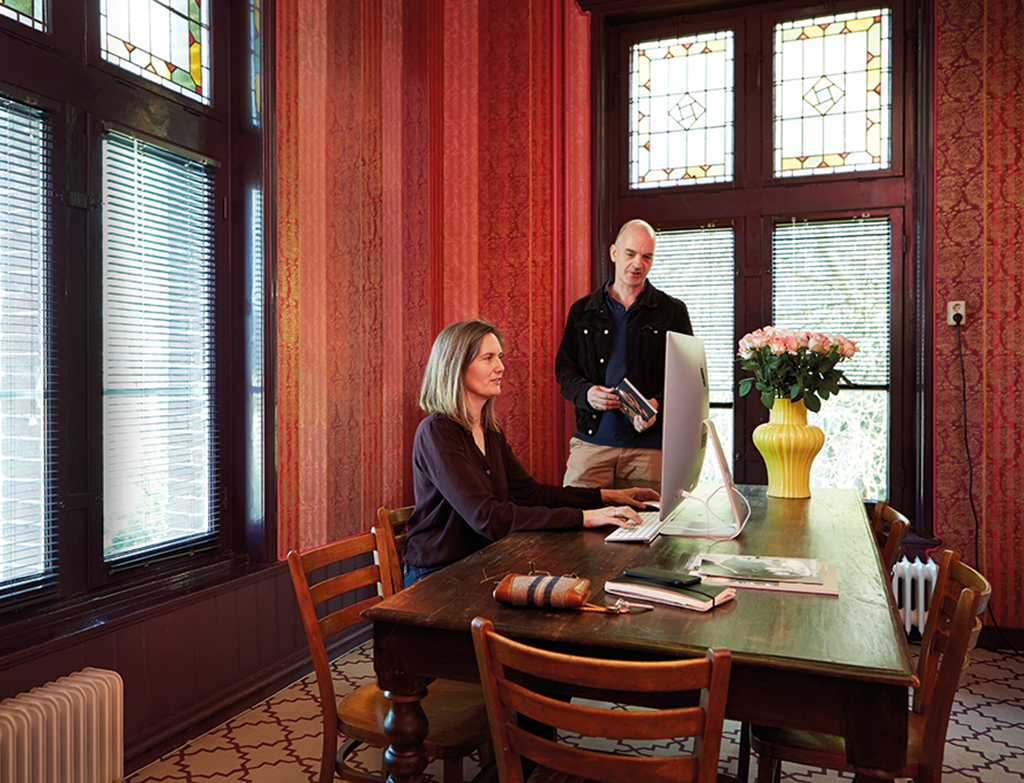
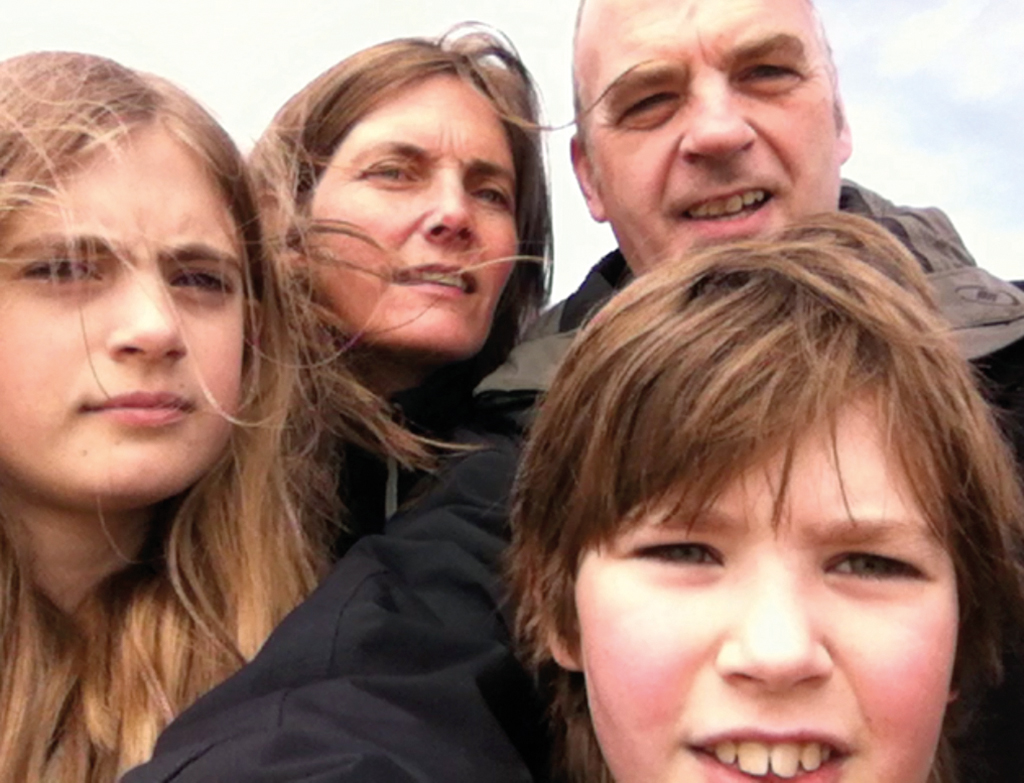
FC van Rixtel
Hanna, Juultje, Robert en Huub, 2012
[Z]OO producties
1992. The first [Z]OO desk calendar was designed by Haico Beukers and illustrated by Nikki Gonnissen, who was Haico’s intern at that time. “We sold fewer copies than we had hoped for.” Eric and Robert discussed the situation while having a beer in an Amsterdam café and decided that it was impossible to go on. In a great coincidence, the next day Robert received a phone call from printer Frans Spruijt. He proposed to engage the members of the so-called ‘Club 12 Graphic Industries’ and have them print the [Z]OO calendar as a promotional gift for their clients. [Z]OO could acquire a number of copies at cost and sell them to make a return on their own investment. From 1992 to 2012, this was the way all-in-all twenty-one extraordinary [Z]OO desk calendars were produced. Each year a different designer was given a free hand in the creation of what often became a collector’s item.
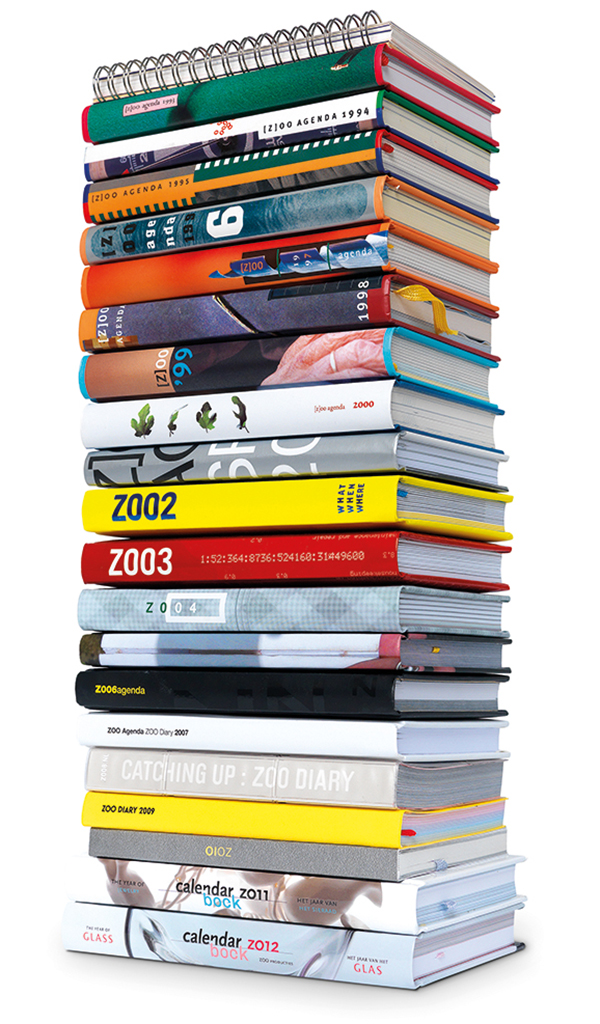
[Z]OO calendars
1992 – 2012
Printed by Club 12 grafische bedrijven
Designed by Haico Beukers (1992), Hans Verlaat (1993), Ton van Bragt (1994), Hans Lodewijkx (1995), Ben Faydherbe & Wout de Vringer (1996), Ab Bol (1997), Annette van Casteren (1998), Peter de Kan & Wim te Brake (1999), Anton Spruit (2000), Dirk Laucke (2001), Eric Hesen (2002), Katherine Szeto (2003), Harmine Louwé (2004), Martijn Engelbregt (2005), The Stone Twins (2006), Vanessa van Dam (2007), Capaz (2008), Coup (2009), Karin van der Kraats (2010), Eric van Casteren & Marjan Unger (2011), Eric van Casteren and Marjan Unger & Job Meihuizen (2012).
1992 was also the year that [Z]OO made ‘shares’ available to friends and colleagues. “These were symbolic shares; the intention was to create a means of compensation of the designers who had worked on a [Z]OO product – a form of dividend.” Shareholders were to receive a copy of each future [Z]OO product. An annual shareholders’ meeting was promised; these became very lively gatherings, many of them taking place above Café Eik & Linde in Amsterdam.
Hans Verlaat designed the first of the [Z]OO calendars, the 1993 edition. The shareholders received their copy during their first meeting, meetings of a kind that in following years became more and more ‘animated’ and included performances of magicians and belly dancers.
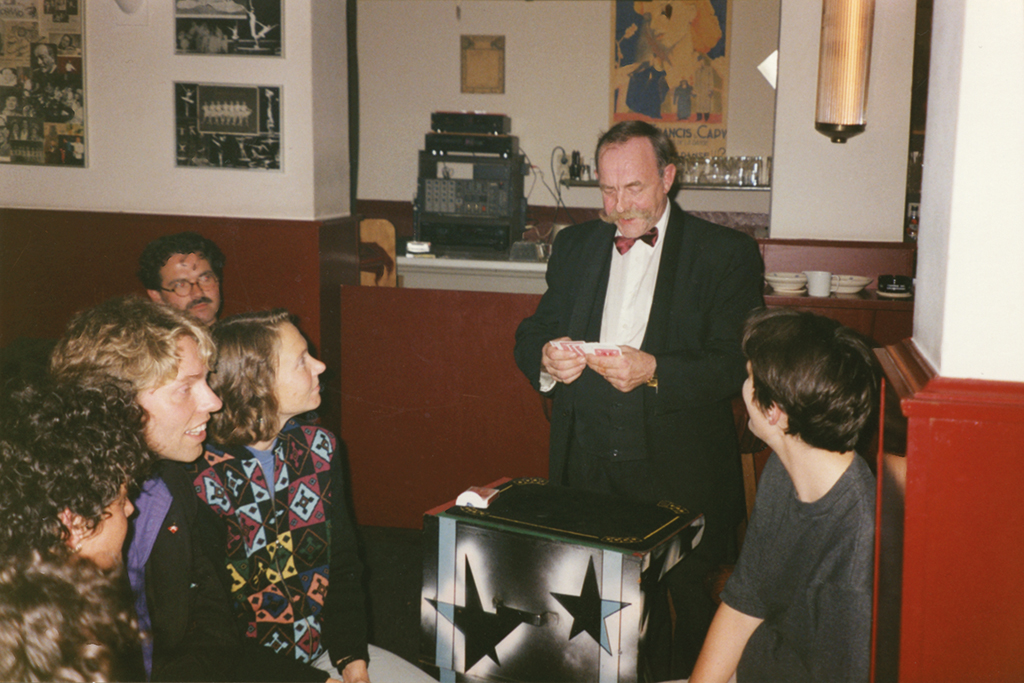
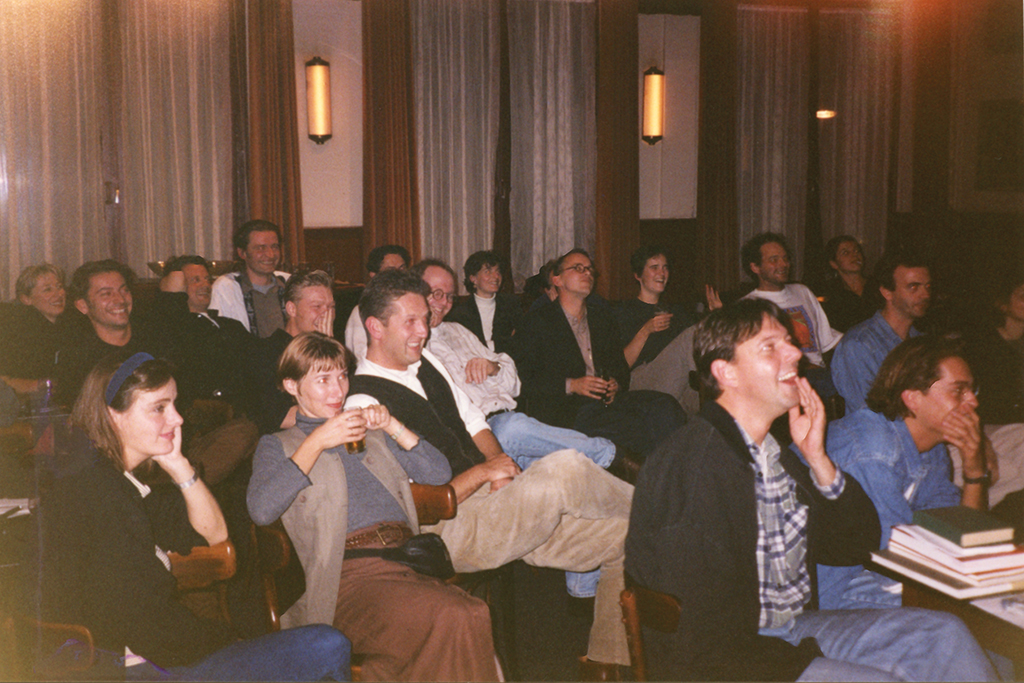
Shareholders’ meeting
Eik & Linde, Amsterdam, October 22, 1994
With a.o. Annita Steketee, Hans Lodewijkx, Hans Booms, Arriette Bos, Denise Ghering, Ab Bol, Aatjan Renders, Dirk Wernik, Simone, Carel van Houte, Jaap Bruynen, Sascha Joseph, Leo Hol, Jean Paul Mombers, Robert van Rixtel and Eric Hesen.
[Z]OO quartet
Another project: fifty-two designers collaborated to create a card game, each contributing one card; the game was printed by Carta Mundi (Turnhout); no money changed hands and [Z]OO received 1,000 copies to sell. Of course, the project needed a celebration: playing the game with many of its contributors on one evening provoked great merriment.
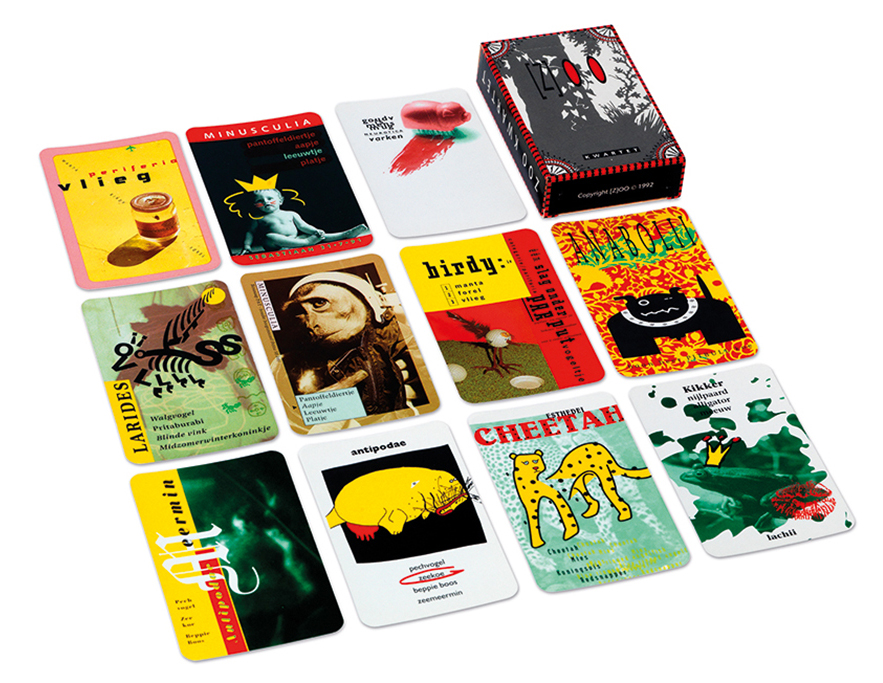
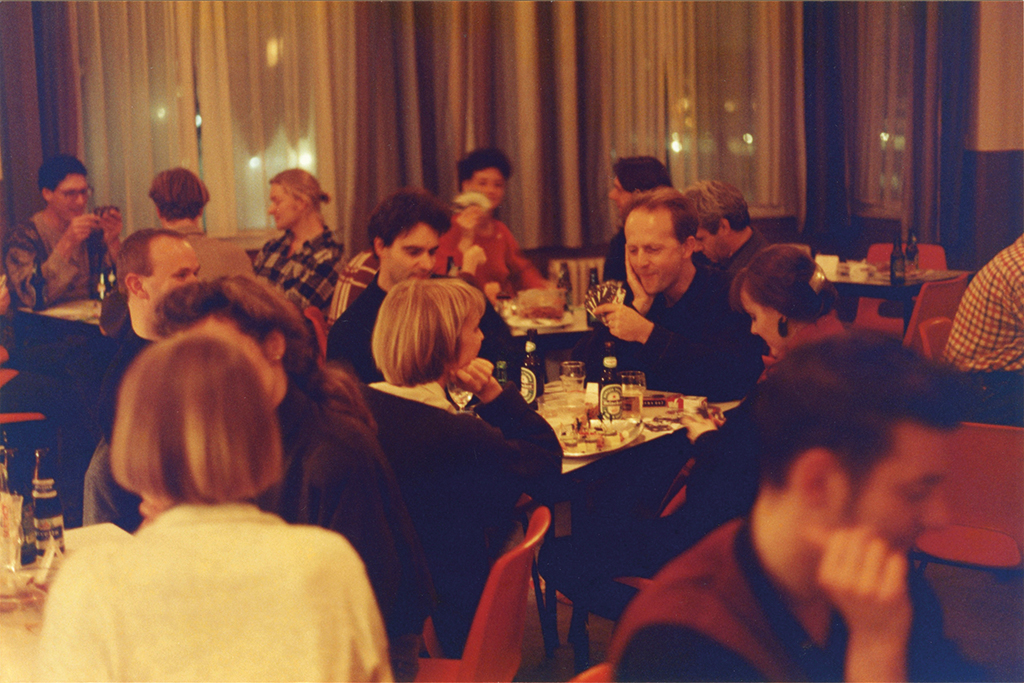
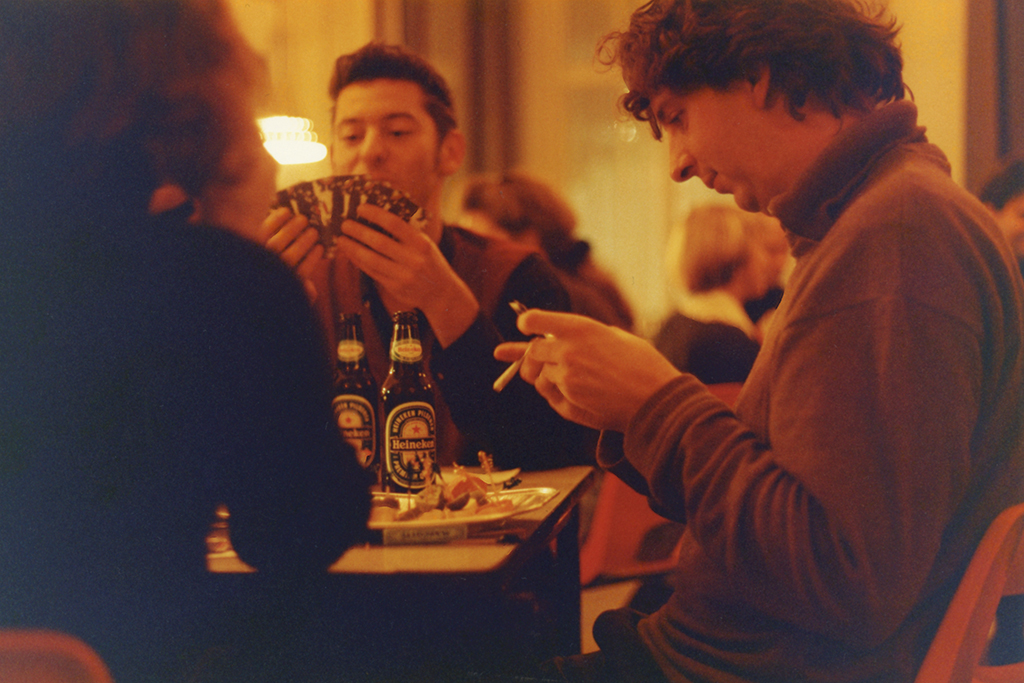
[Z]OO quartet
December 1992
In collaboration with Gerben Klinkenberg and Annita Steketee
With André Bakker, Samira Benlaloua, Ab Bol, Hans Booms, Ariëtte Bos, Ben Bos, Hans Blom, Ton van Bragt, Dicky Brand, Eric van Casteren, Tom Couvee, Stoffel den Drijver, Peter Dingemans, Gijbert Dijker, Henny van Eck, Hester Elemans, Jan van den Elshout, Denise Ghering, Tineke Groen, Dick de Groot, Reinoud van Hasselt, Eric Hesen, Erik Hoebergen, HansWerner Holzwarth, Carel van Houte, Christa Jesse, Sacha Joseph, Peter de Kan, Gerben Klinkenberg, Godfried Konings, Marisa Klaster, Victor de Leeuw, Frans Lieshout, Hans Lodewijkx, Joost Luk, Pieter Mineur, Jean-Paul Mombers, Xandra Neerincx, Anja Nienstedt, Eric Nuyten, Mathieu Pauwels, Theo Peters, Gert Jan van der Putten, Ris van Overeem, Aatjan Renders, Robert van Rixtel, Peter de Rooden, Gertjan Rooijakkers, Wouter van der Schans, Loes Schepens, Pauline Schimmelpenninck, Nicole van Schouwenburg, Jantien Slob, Annita Steketee, Pieter Vandermeer, Harry Verdijk, Hans Verlaat, Anton Vos, Dirk Wernik, Annemie Wolfs and Marja Zuurman.
De Favorieten
In October 1995, all shareholders received the 1996 desk calendar, the last one to be seen as a [Z]OO dividend. What came after shareholding, was called ‘De Favorieten’ (the favorites). Friends, acquaintances and colleagues were asked to contribute now and then to publications about the (recent history of the) graphic design profession. In 2003, some 117 people joined. “With more than one-hundred people you have an effective, powerful network that allows you to make great productions just by settling on mutual terms.”
1 + 1 = 3
At the Frankfurter Buchmesse of 1993, the Netherlands was appointed its ‘Schwerpunkt’, its focal point. Robert wanted to do something with a group of designers. “It is my fate that once I get an idea, I have to get it realized.” Twenty-four designers, 24 illustrators and 24 authors came together to create the book 1 + 1 = 3 in three languages; it was to be the Dutch government’s goodwill-present. Hans Bockting joined the team to help organize the project; author/critic Atte Jongstra took care of the selection of the authors. Robert contacted Frank Ligtvoet (of the Dutch literary productions and translation foundation) for a grant. “You always need a certain amount of money to get started, even when a project is funded by donors and sponsors for 85%.” Ligtvoet discovered that [Z]OO would not profit from instigating the project and supported their request of a 15,000 guilder subsidy from the ministry of education and culture. “Guess what we discovered after arriving at the Buchmesse? They’d put up our books for sale! This taught me to never let anyone else organize the presentation of a new [Z]OO publication to celebrate its successful production.”
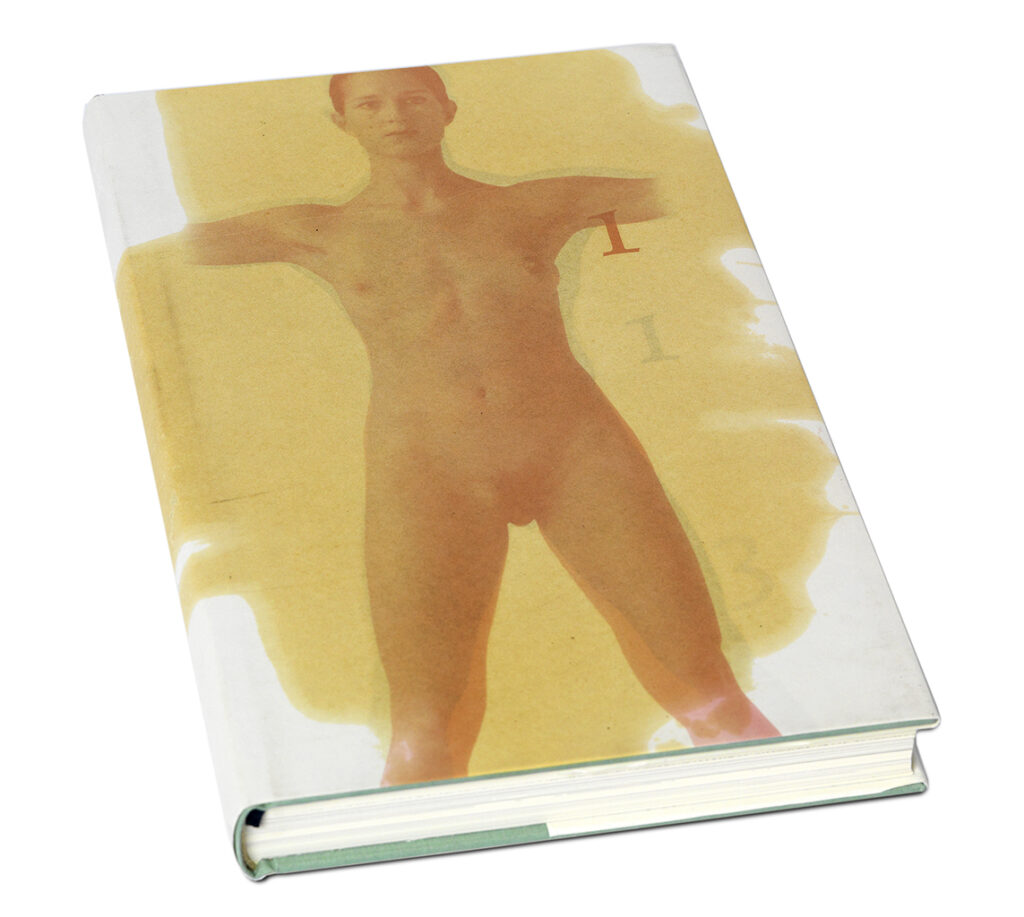
1 + 1 = 3
Frankfurter Buchmesse, 1993
In collaboration with Hans Bockting
With Marcel Möring + Henk Hoebee, Jacq Vogelaar + Amanda Bosman, Atte Jongstra + Marten Jongema, Henk Pröpper + Ben Faydherbe / Wout de Vringer, Kristien Hemmerechts + Jacques Koeweiden / Paul Postma, Leo Plezier + Toula Antonakis / Tonnus Oosterhoff + Haico Beukers, Renate Dorrestein + Vero Cricks, Huub Beurskens + Reinoud van Hasselt, Daan Cartens + Paul Bogaers, Nelleke Noordervliet + Karen Wakkers, Bas Heijne + Arthur Bagen, Toon Tellegen + Menno Landstra, Bart Plouvier + Rik Comello, Monica van Paemel + Eric van Casteren, Ton Lanoye + Berry van Gerwen, Willem Brakman + Jola Hesselberth, Patricia de Martelaere + Geert Setola, Stephan Sanders + Toon Michiels, Margriet de Moor + Stefan Hengst, Keest ‘t Hart + Robert van Rixtel and M. Februari + Frits Deys.
Nederland Indonesia
1993 was also the year Robert visited Indonesia accompanied by his father. “The next year, I learned that in 1995 the Indonesians would celebrate the 50th anniversary of their independence. I wanted to do something.” Eric van Casteren knew his way around several government departments in The Hague. “The ministries of culture and foreign affairs promised us a 40,000 guilder grant. The plan was to create a book from the perspective of the cultural interaction of the two countries, with the text (in Bahasa Indonesia and Dutch) to be contributed by authors from different cultural sectors and professions. Garuda, the Indonesian air carrier, sponsored Sybrand Zijlstra’s journey to Indonesia (he had just taken leave from the Netherlands Design Institute). With support of the Dutch embassy in Jakarta, he would interview all kinds of people, do research for the project, and write a chapter about design in Indonesia. The project also received grants from the City of Rotterdam and the Tropeninstituut (institute for the tropics) in Amsterdam.”
Eric had found another sponsor at Nutricia, the food producer, but after learning that Indonesian dissidents, too, would be interviewed, they withdrew the promised 40,000 guilders. The project was in danger. After discussing the dire financial straits, Robert and Eric at first decided to cancel the whole project. “Then we realized that, with so many commitments already having been made, it would be more economic to continue than to cancel. We sold three-hundred copies that Queen Beatrix would present to Indonesian government officials and to CEOs within the Dutch and Indonesian business communities. One of the sponsors, the City of Rotterdam, was nice enough to buy another stack of the books. In the end, we were able to cover all expenses.”

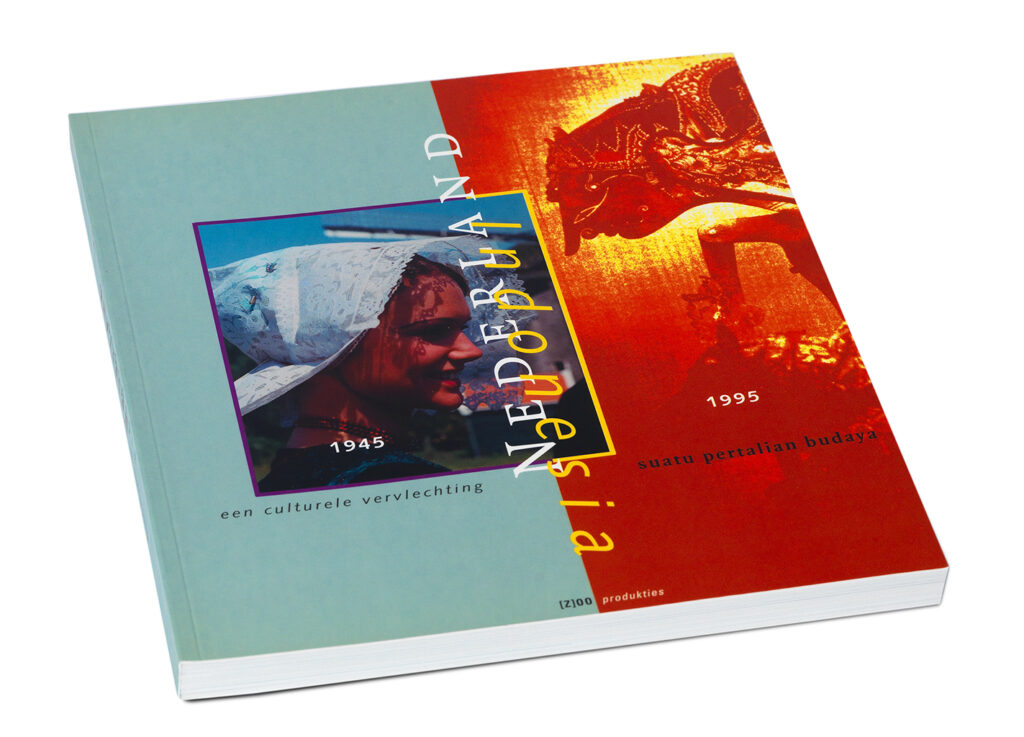
Nederland Indonesia
1945 – 1995
Een culturele vervlechting
1995
With Hester Wolters, Bram Buize, Eric van Casteren, Pienke Kal, Anneke Veldhuisen and Sybrand Zijlstra.
Galeislaven en Rekentuig
In 1997, Frans Spruijt stepped back as chair of the Grafische Cultuurstichting (graphic culture foundation). Robert came up with the idea to create a book to commemorate Spruijt’s career in the graphic industry. Sybrand Zijlstra and Jaap van Triest edited Galeislaven en Rekentuig. Drukkers, Ontwerpers en de Vooruitgang (Galley slaves and calculators. Printers, designers, and progress). Just as other [Z]OO publications do, its colophon mentions the names of scores of sponsors and donors. The book paid attention to the developments in the graphic industry and especially of typesetting, but also emphasized the importance of the many goodwill publications produced by different Dutch printers. “This tradition brought about a range of important documents: the Kwadraatbladen (squares) of steendrukkerij De Jongh & Co.; the cahiers published by Lecturis; the square books Rosbeek produced for clients and the design world; Spruijt’s calendars; Proost Prikkels newsletters; and the Thieme foundation’s publications. These wonderful publications have inspired me in many ways.”
Four printers collaborated with the production of the Spruijt book; it was introduced during a meeting in the Stedelijk Museum during which Petr van Blokland, Wim Crouwel, Henk Gianotten and Paul Mijksenaar spoke. Robert took two-hundred copies with him to Eindhoven and the remaining copies would be transported by Goof Rutten, who had just installed a liquid gas tank in his new Jeep Cherokee. The gas tank exploded halfway; some thousand copies of Galley Slaves and Calcultors were lost. “We never did a reprint. But the book became a collector’s item.”
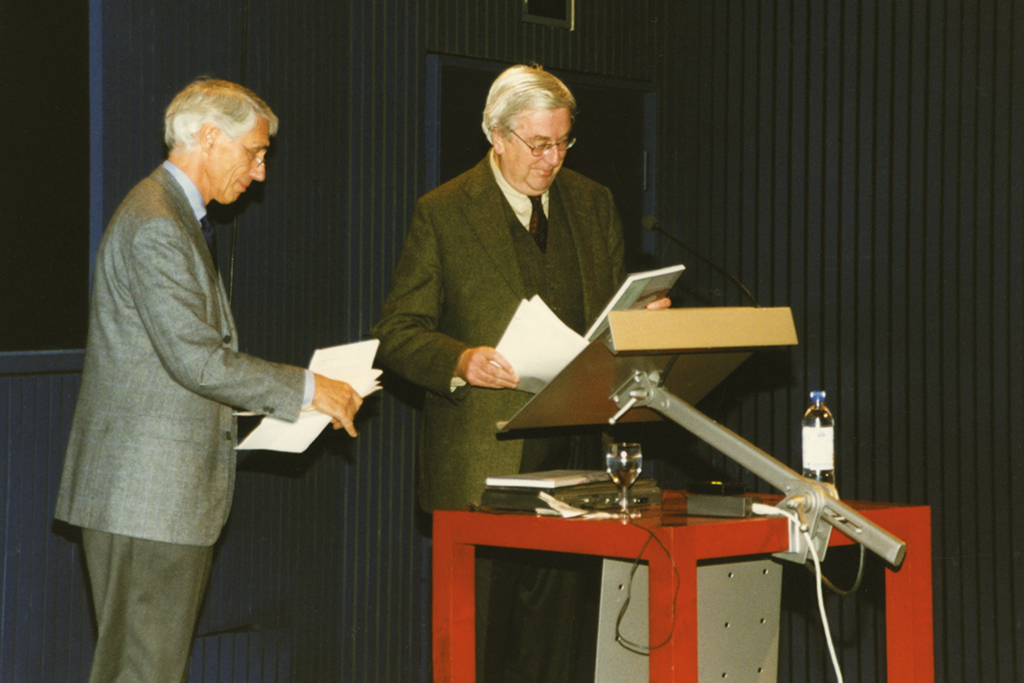
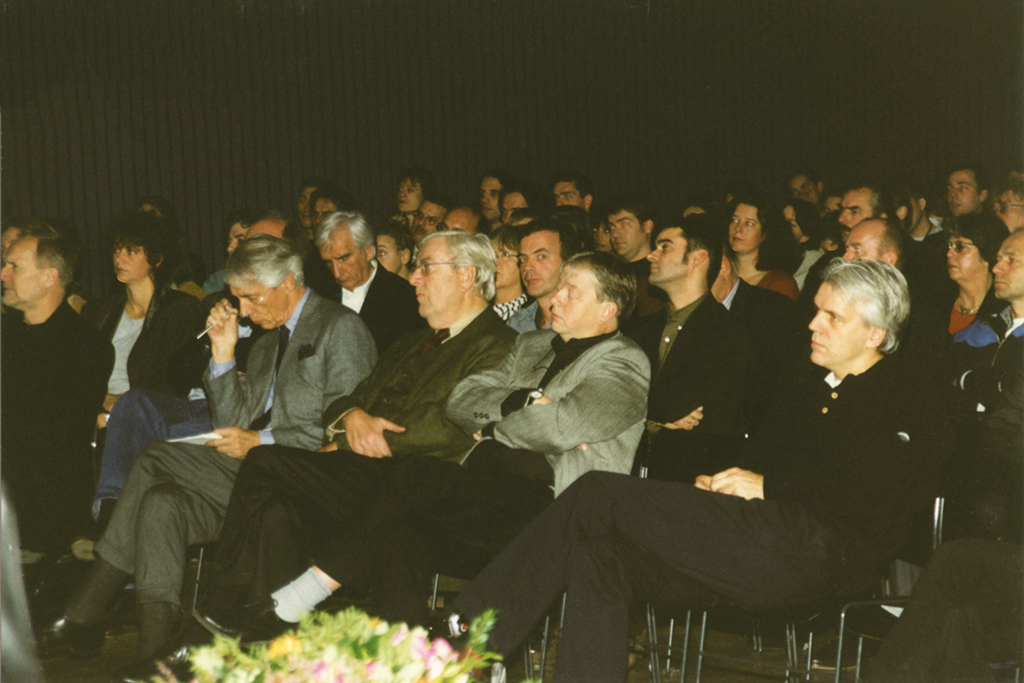
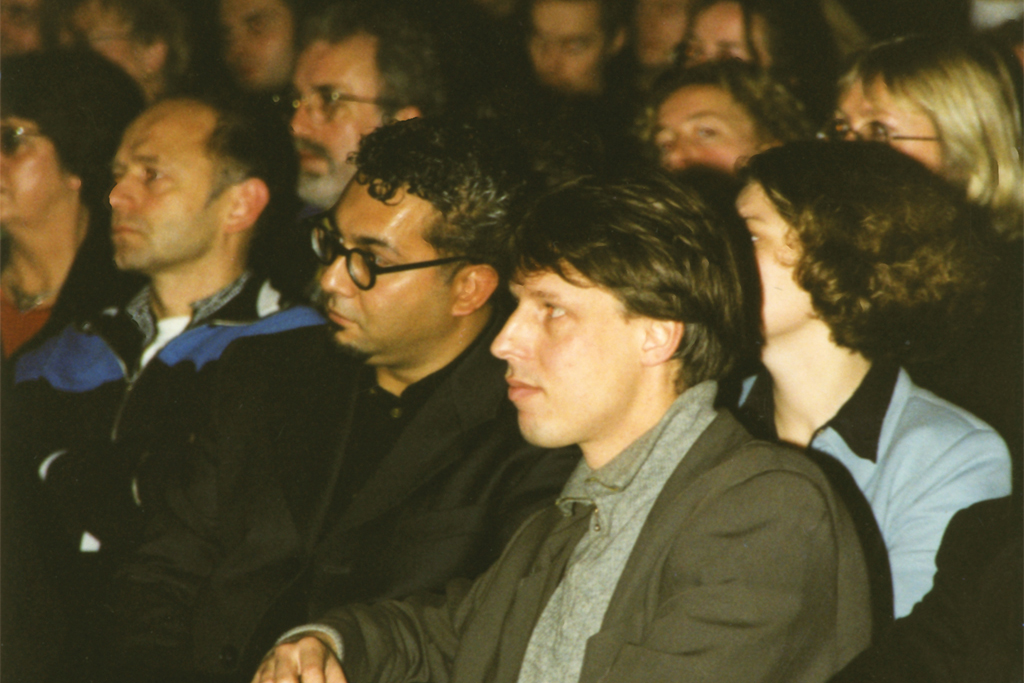
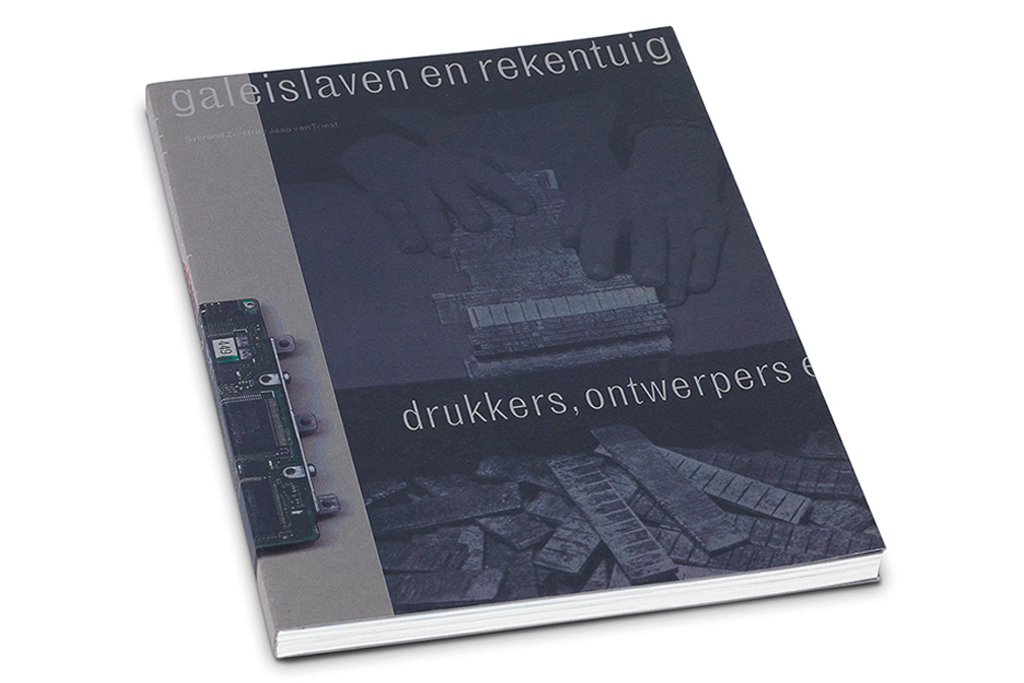
Galeislaven en Rekentuig
Stedelijk Museum, Amsterdam
December 7, 1997
Speakers: Petr van Blokland, Wim Crouwel, Henk Gianotten, Paul Mijksenaar and Frans Spruijt.
Monographs
The book also became the inspiration for the series Monographs About Design that [Z]OO produced in collaboration with Veenman and Lecturis printers: books about pictograms, different sorts of paper, type, fragrance, exhibition design, web design, and stage design respectively. “What I want to accomplish is: getting a book including its message out among the people. It’s not necessarily selling that I am after. Giving books away is just as good, as long as they reach the right audience.” The presentation of each new monograph was combined with a symposium in De Rode Hoed in Amsterdam. “Participants received the book, free of charge. But they paid for attending the symposium. This set-up worked like a charm, there were times we assembled three-hundred people. From the ticket sales we were able to pay for the location and the coffee, and the books too. If we had done it differently, symposium free and books for sale, we would have sold thirty books, tops.”
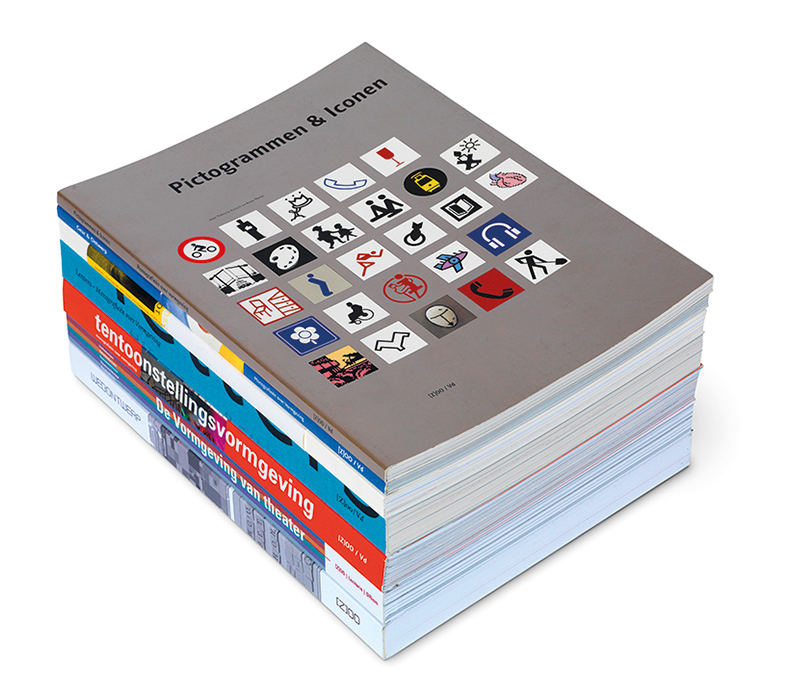
Monographs about design
1998 Pictograms and icons
1999 Fragrance
2000 Paper
2001 Type design
2002 Exhibition design
2004 Web design
2005 The design of theater
Each time presented with a symposium at the Stedelijk Museum or the Rode Hoed, Amsterdam.
Roots
Greve Offset in Eindhoven yearly published four small books of sixteen pages each about the seasons. Leen van Veen, Greve’s director, invited a different designer for each edition. But when he asked Robert to design one, Robert declined. “I told Leen that it would make more sense if the series had a serious subject instead of something trivial like the four seasons. I came with the idea of creating a series about the post-war generation of Dutch graphic designers. Some had fat tomes made about their work, but many were in danger of being forgotten.”
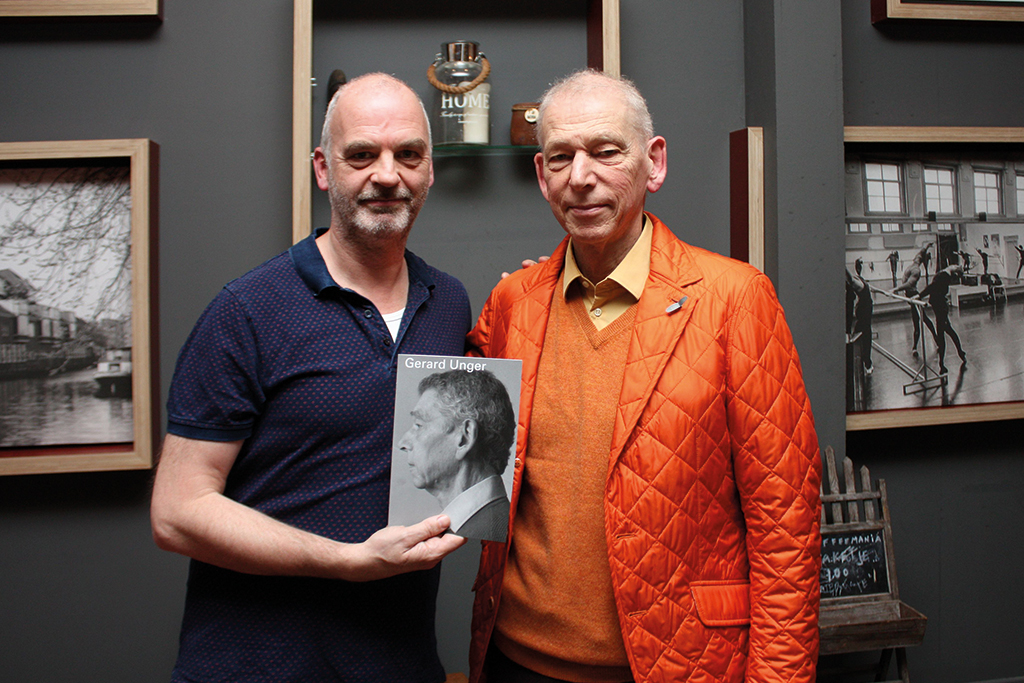
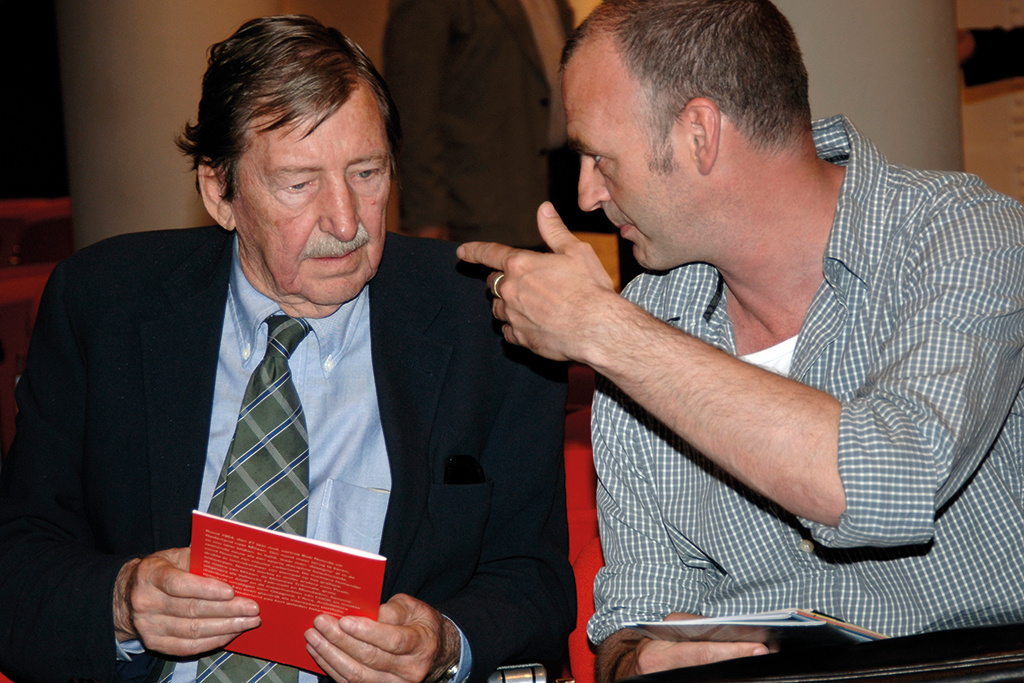
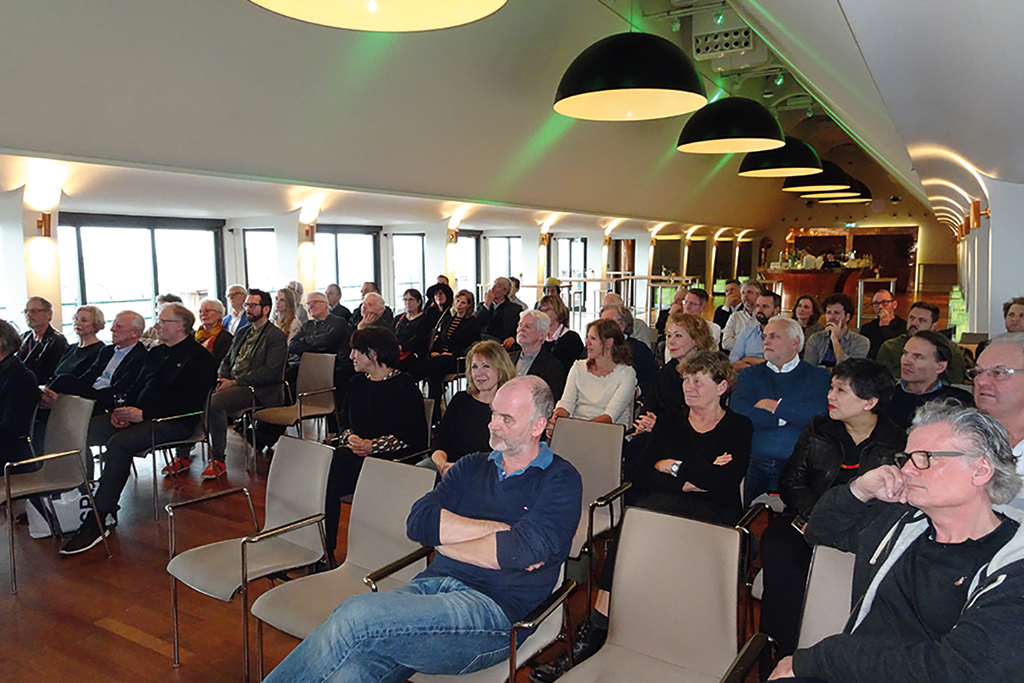
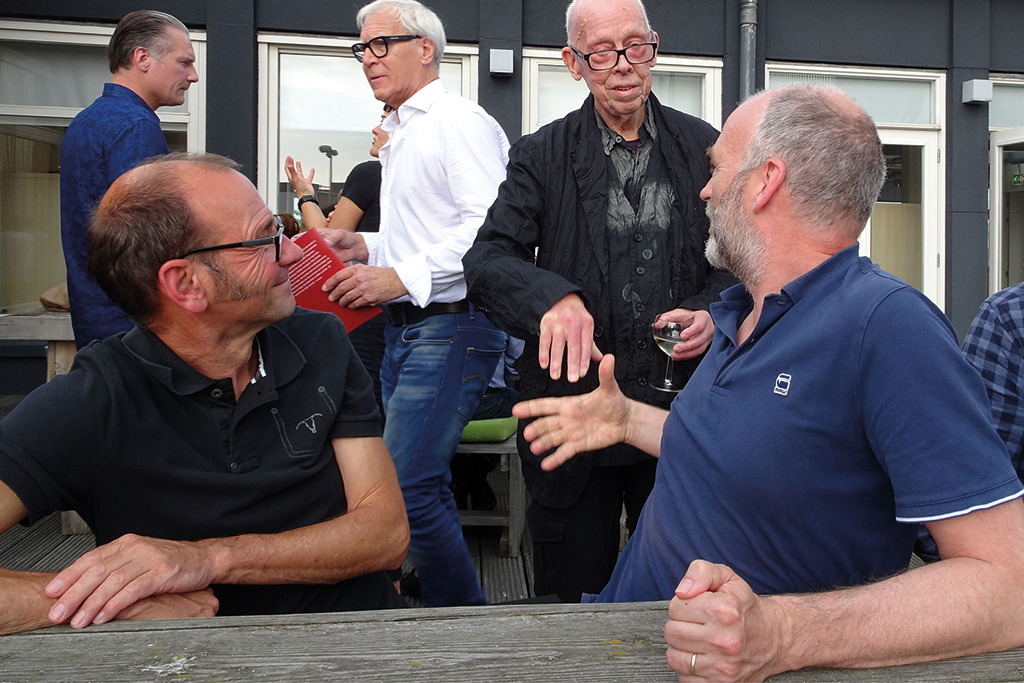
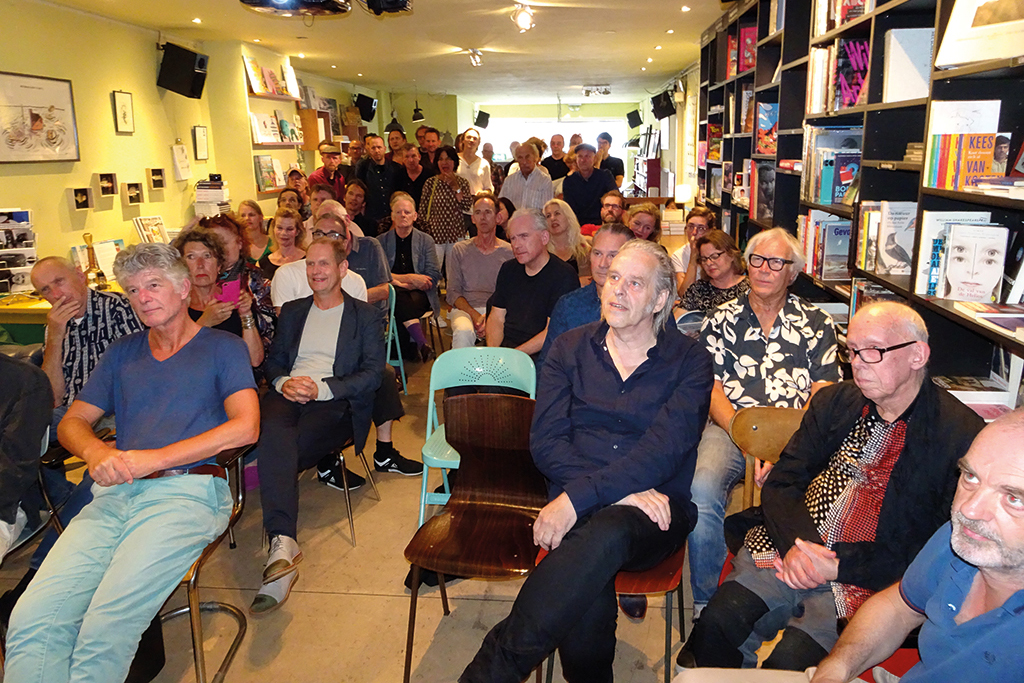
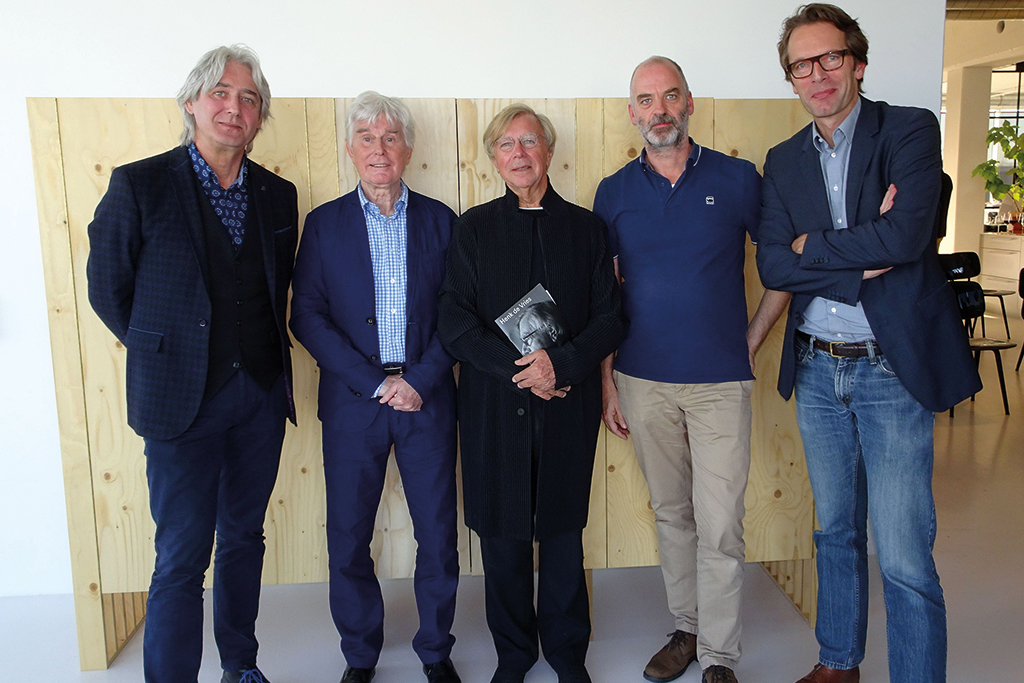
Roots presentations
Fifty meetings from 2005 to the present.
Often at the BNO, but when it was convenient
also at various other locations.
This is how ‘Roots’ started. Paul Mertz was the first one who got his own ‘Roots’ cahier; his story was written down by Paul Hefting. It was May 2005. Sixteen pages, 3,800 words, thirty images. Robert made a deal with the association of designers, BNO (he was a member of their supervisory board), to send ‘Roots’ along with their members’ magazine Vormberichten to all 3,000 BNO members. “That’s how ‘Roots’ became a big hit, which I hadn’t expected.” After Greve stopped participating, first Lecturis, then Wilco Art Books took over. Arctic Paper Benelux sponsors the paper, Aartjan Renders shoots the cover portraits. Each new ‘Roots’ cahier is launched at the BNO offices, in a café, a design studio, a museum or a record shop. Not long ago we received a grant from Pictoright foundation to publish the first fifty cahiers on the internet (www.dutchgraphicroots.nl); they are translated and edited in English by Ton Haak.
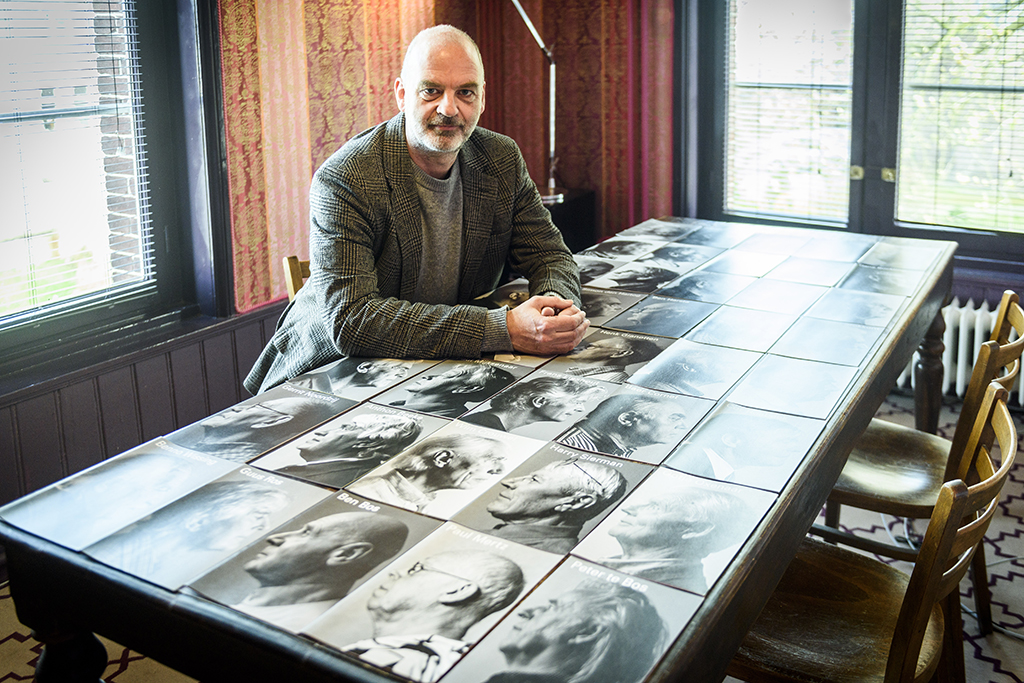
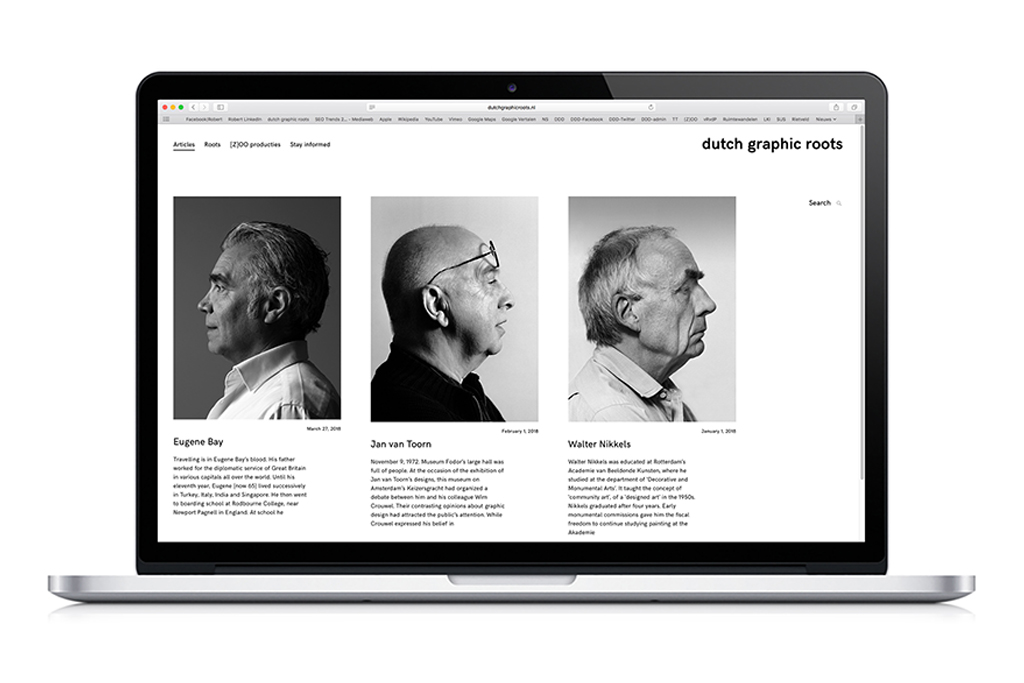
Dutch Graphic Roots
In order to meet the international demand for Roots, [Z]OO productions has started a bilingual website (NL-Eng) called ‘Dutch Graphic Roots’.
www.dutchgraphicroots.nl
The Debate
Wim Crouwel – Jan van Toorn
November 2, 2008, Felix Meritus, Amsterdam
In collaboration with Premsela, BNO and NAGO
Lectures and book launch. Also the celebration celebration of Wim Crouwel’s 80th birthday. With Wim Crouwel, Jan van Toorn, Chris Vermaas, Jeroen van Erp and Mieke Gerritzen. Chairman of the day: Titus Yocarini
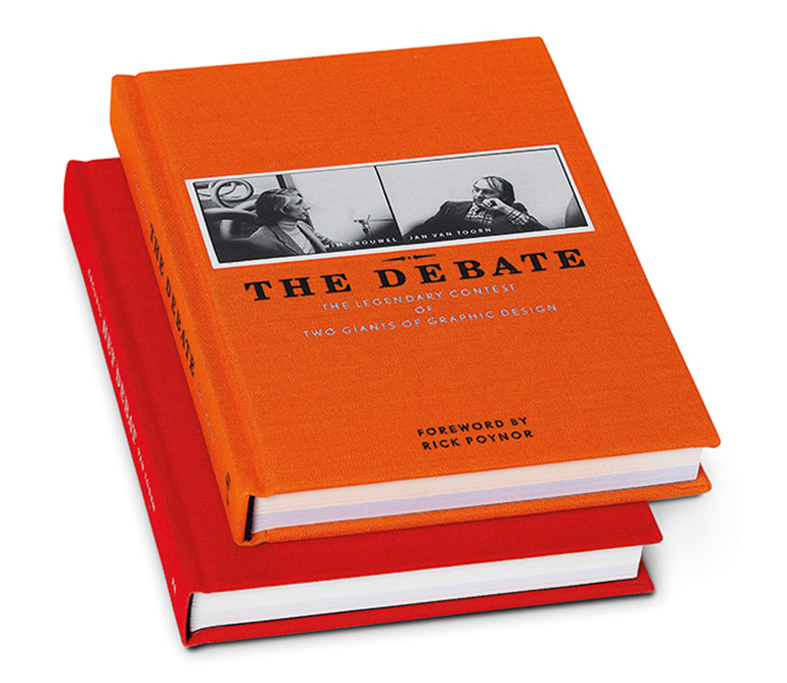

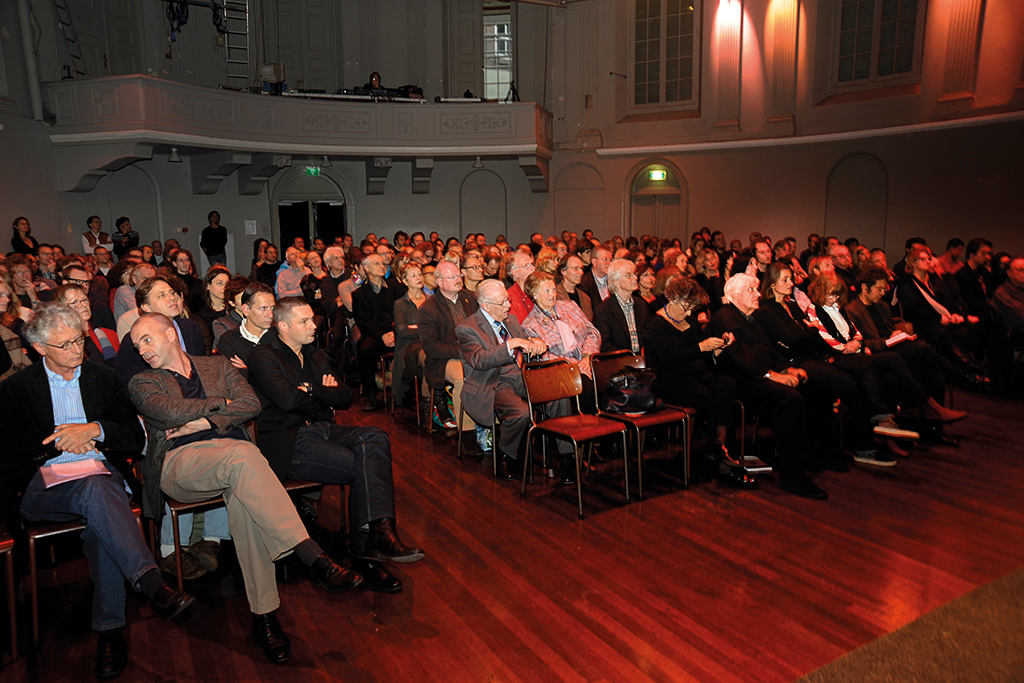
Young at Heart
Vormberichten had published a series of interviews with older designers, written by Guus Ros. In 2007, [Z]OO bundled these interviews in a book, Senior Ontwerper Gevraagd (Wanted, senior designer). This was the first production that was realized in collaboration with De Favorieten. The publication was financed by Premsela foundation, BNO, Elco printers, Papyrus and Meeuwis bookbinders. “I am eager to find projects that are really interesting in content but normally would never be realized. That’s how you can get people involved. You should never ask for too much, only a contribution you yourself would agree to.”
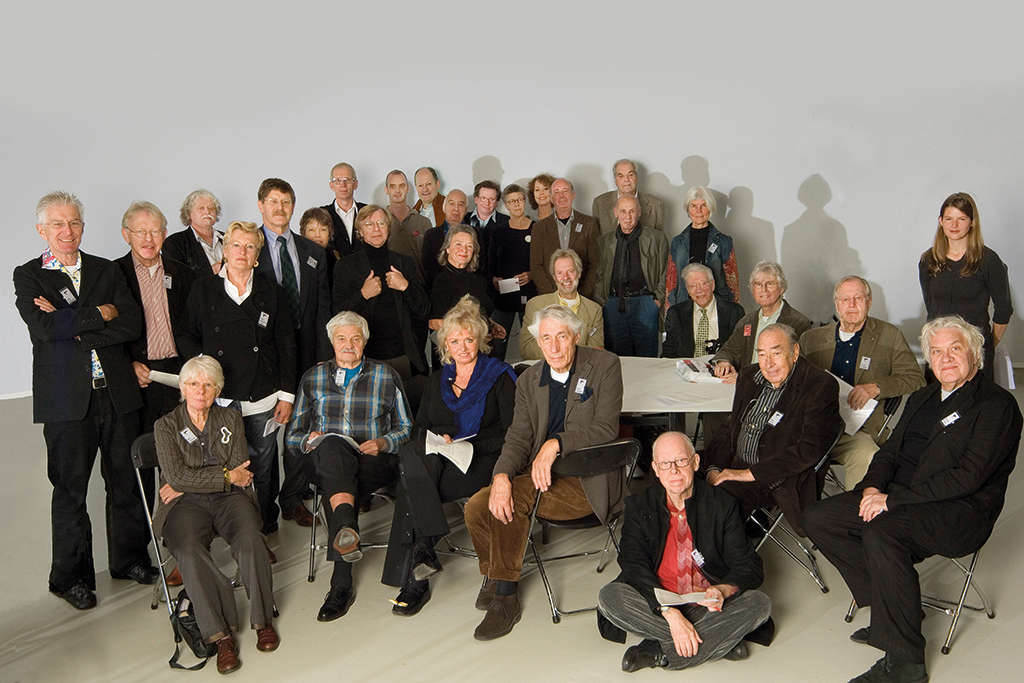
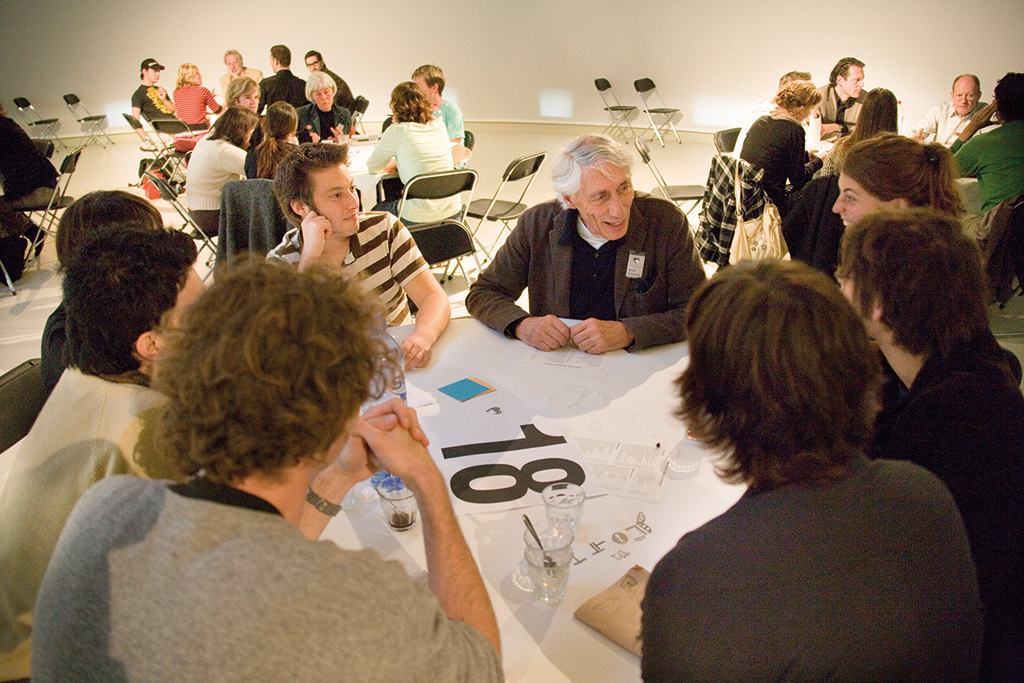
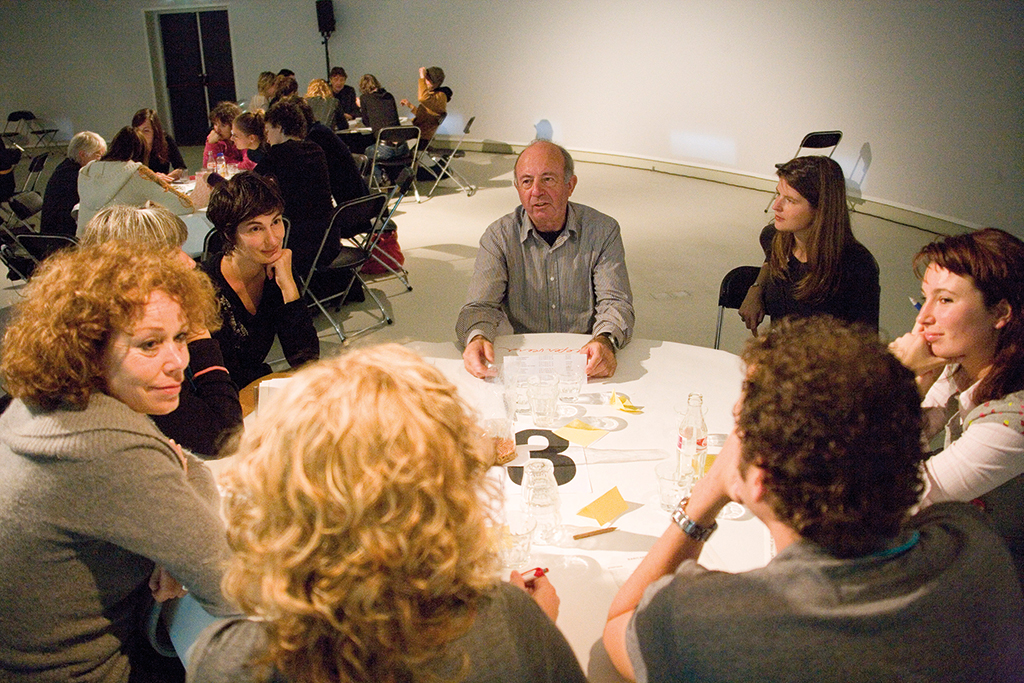
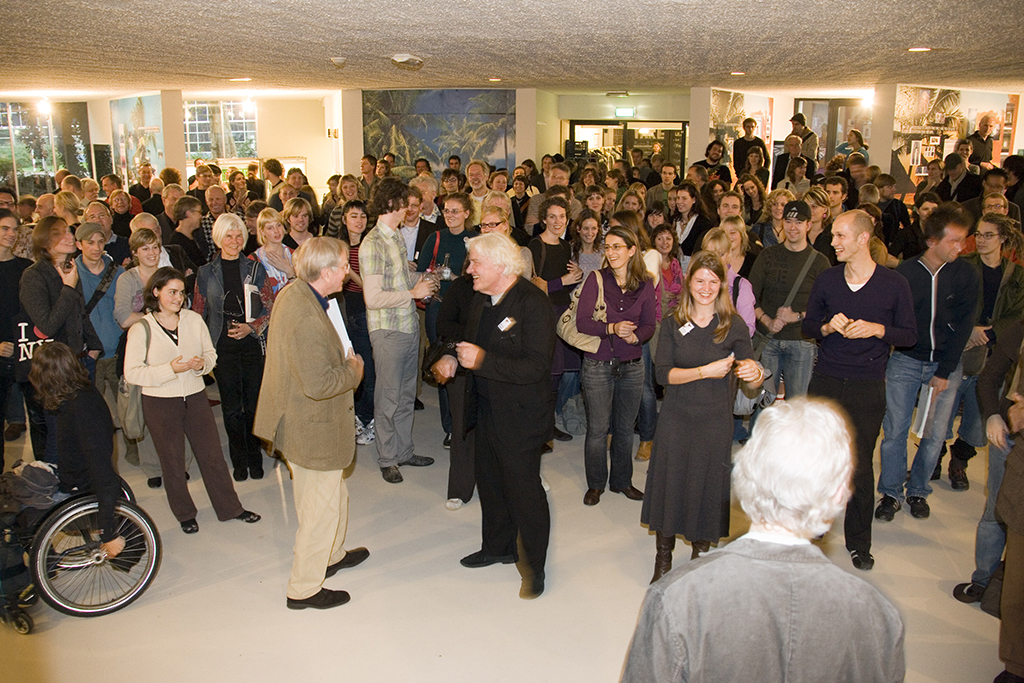
Young at Heart #1
Platform 21, Amsterdam, October 28, 2006
In collaboration with BNO and Premsela
Experienced designers discuss their profession with young designers and design students
With Hans Appenzeller, Ben Bos, Jan Brinkman, Wim Crouwel, Jaap Drupsteen, Daphne Duijvelshoff-van Peski, Ria van Eyk, Marijke de Goey, Puck & Hans Kemmink, Friso Kramer, Nel Linssen, Jan Lucassen, Louis Lücker, Paul Mertz, Bruno Nynaber, Rob Parry, Nel Punt, Swip Stolk, Jan van Toorn, Henk de Vries and Siep Wijsenbeek. Chairmen of the day: Anthon Beeke and Annelys de Vet.
“Then, I had the idea of organizing round table discussions between young designers and experienced professionals. This could be a way to pass on experiences and stories. These gatherings became the Young at Heart sessions, supported by BNO and Premsela. October 2006 was the day of the first session, in Platform 21 in Amsterdam. Three-hundred participants! Subsequent meetings took place at the Gerrit Rietveld Academy in Amsterdam and twice during the Dutch Design Week in Eindhoven.”
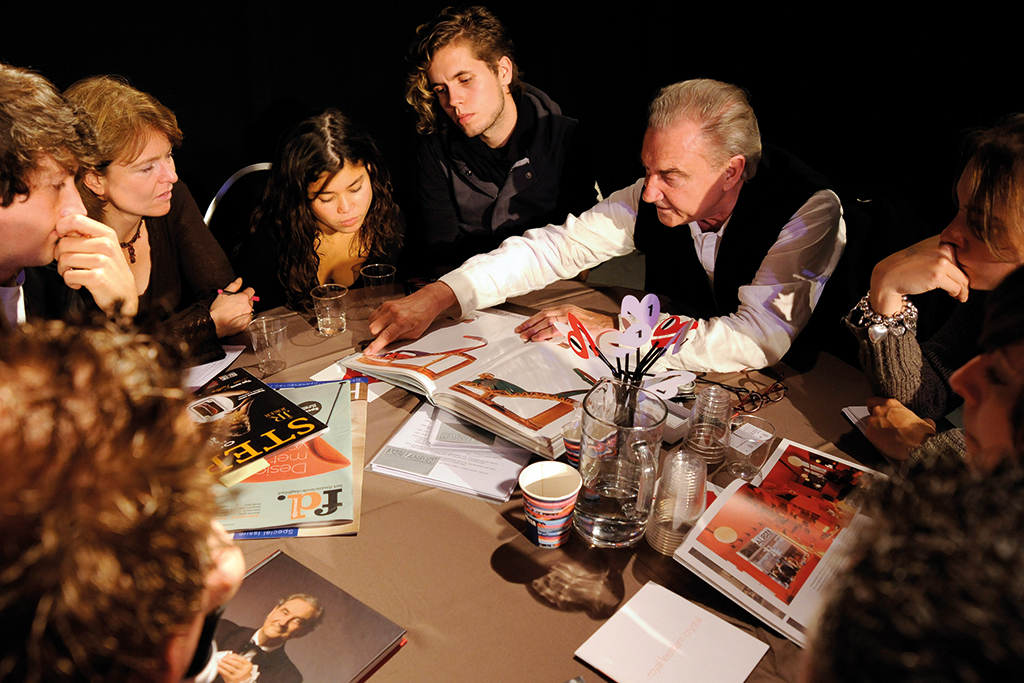
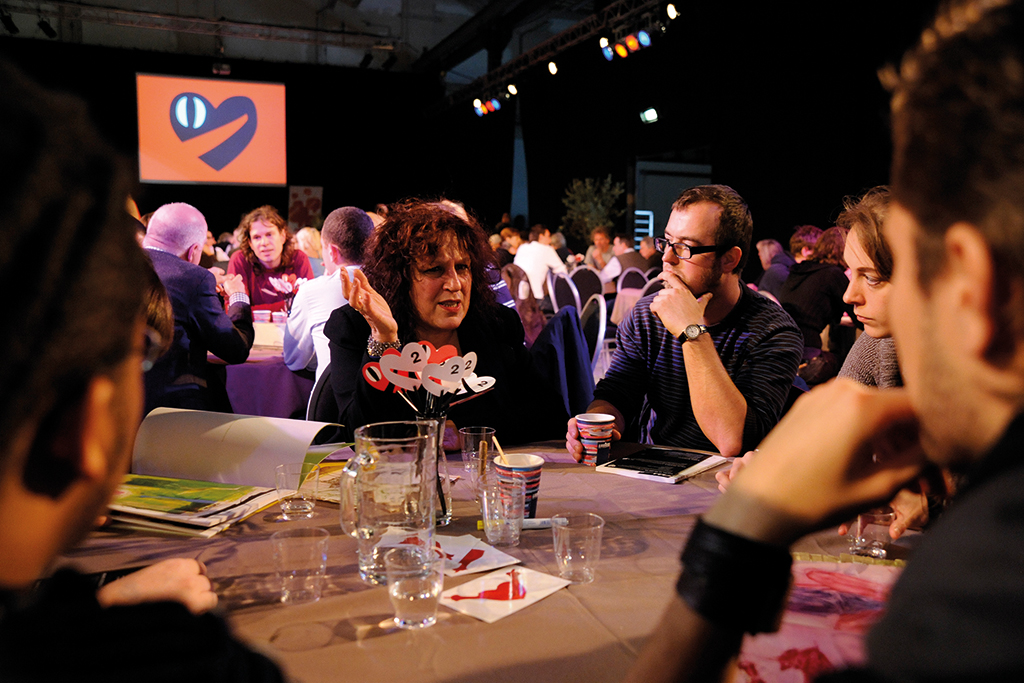
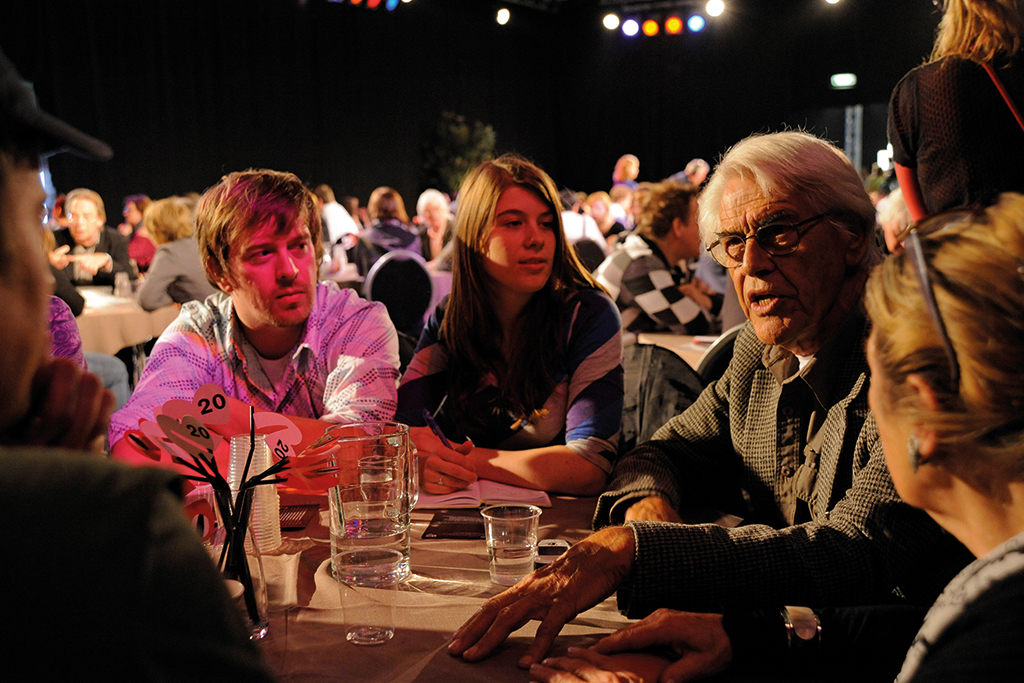
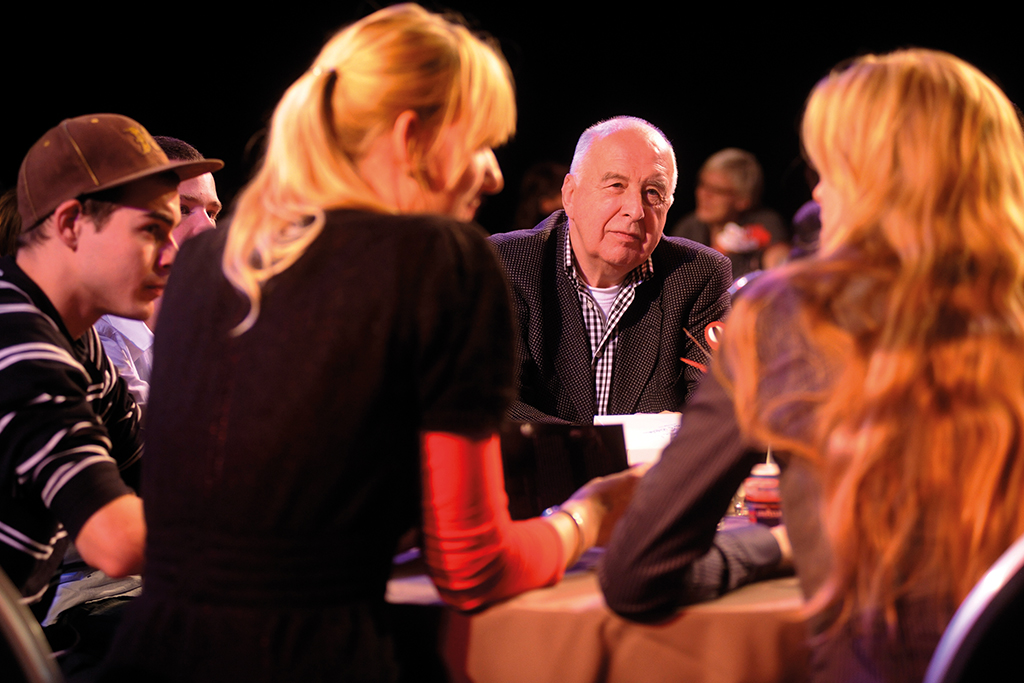
Young at Heart #3
During Dutch Design Week
Klokgebouw Eindhoven, October 19, 2008
In collaboration with BNO and Premsela
Experienced designers discuss their profession with young designers and design students.
With Hans Appenzeller, Anthon Beeke, Gerard van den Berg, Jet Boeke, Hans Dirken, Jan van Duppen, Ria van Eyk, Piet Gerards, Patrice Girod, Joke van Hengstum, Milou Hermus, Jan Jansen, Milou Ket, Cyprian Koscielniak, Friso Kramer, Karel Martens, Evelyne Merkx, Ralph Prins, Frans van der Put, Guus Ros, Anne Stienstra, Joost Swarte, Jan van Toorn, Marjan Unger, Rick Vermeulen, Jeroen Vinken and Ad Werner. Chairmen of the day: Anthon Beeke and Nadine Sterk.
Monographs and exhibitions
[Z]OO, in collaboration with publicist/collector Peter van Dam and Roto Smeets printers, created a series of monographs and parallel exhibitions dedicated to Art in Philips advertising 1891-1941 (2005), L.C. Kalff (2006), N.P. de Koo (2008) and Ella Riemersma (2010). The books and exhibitions presented hundreds and hundreds of images coming from Van Dam’s private collection. In 2012, Van Dam also wrote a well-illustrated company history of Cacaofabriek C.J. van Houten; this book was published by [Z]OO together with Lecturis.
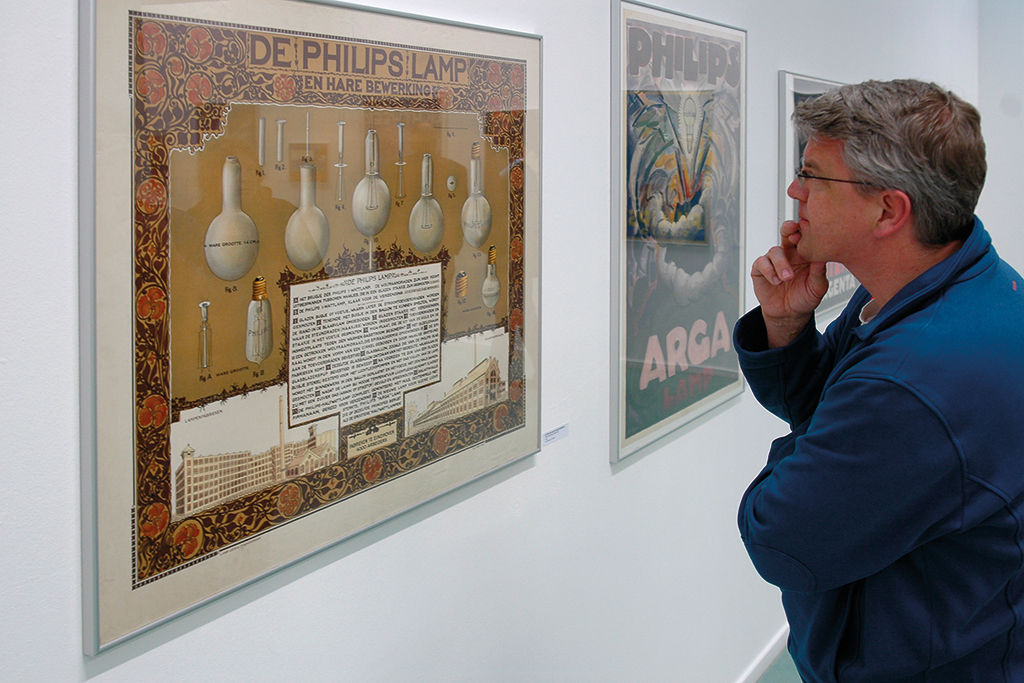
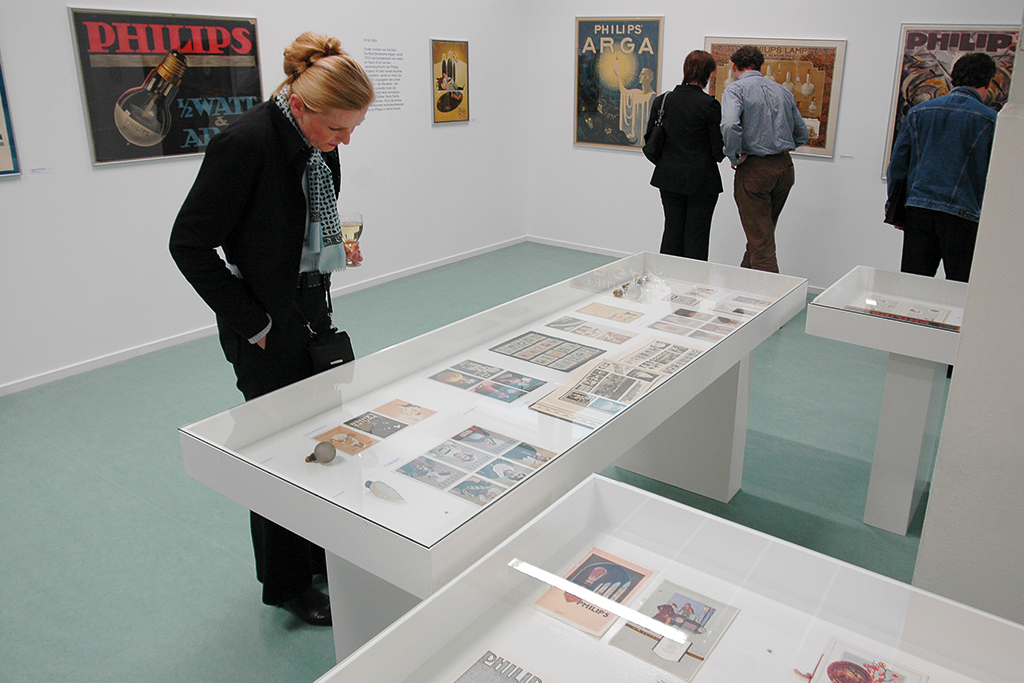
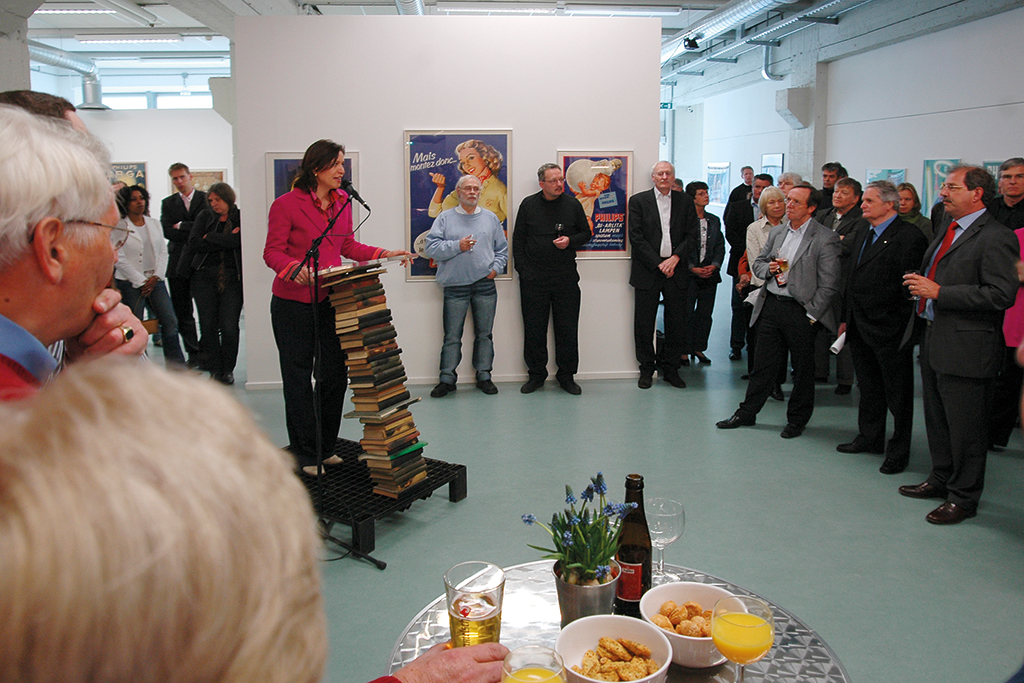
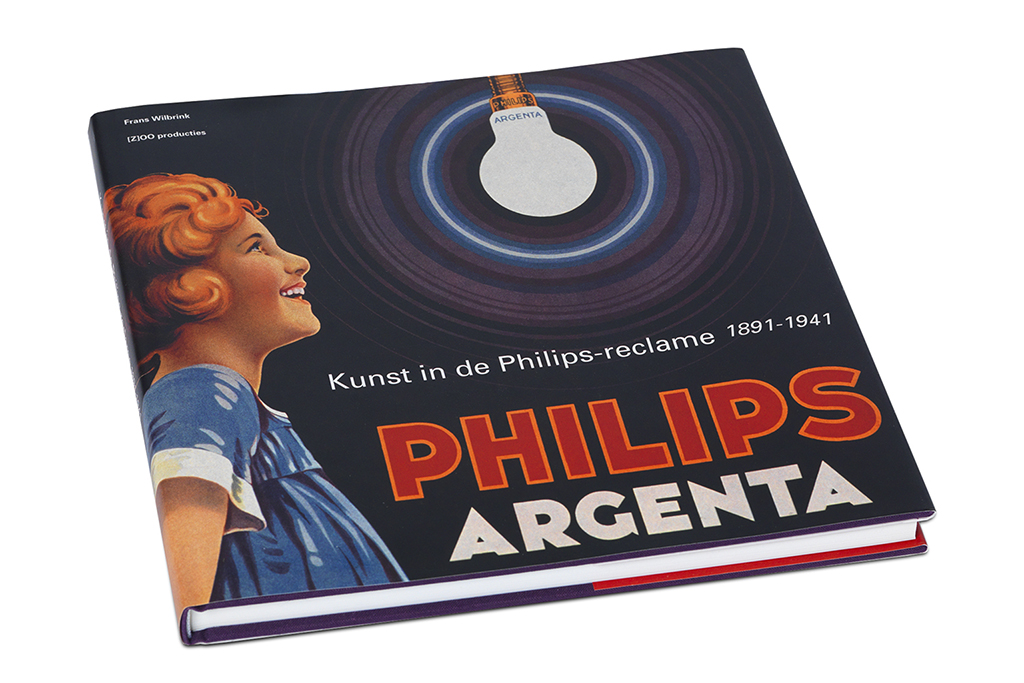
Kunst in de Philips-reclame
April 9 – May 8, 2005
CBK De Krabbedans, De Witte Dame, Eindhoven
In collaboration with Hanneke van den Nieuwenhof and Han le Blanc
On the occasion of the publication of the book ‘Kunst in de Philips-reclame (1891-1941)’. Author Frans Wilbrink.
Exhibition with lectures by Esther Cleven and Dingeman Kuilman.
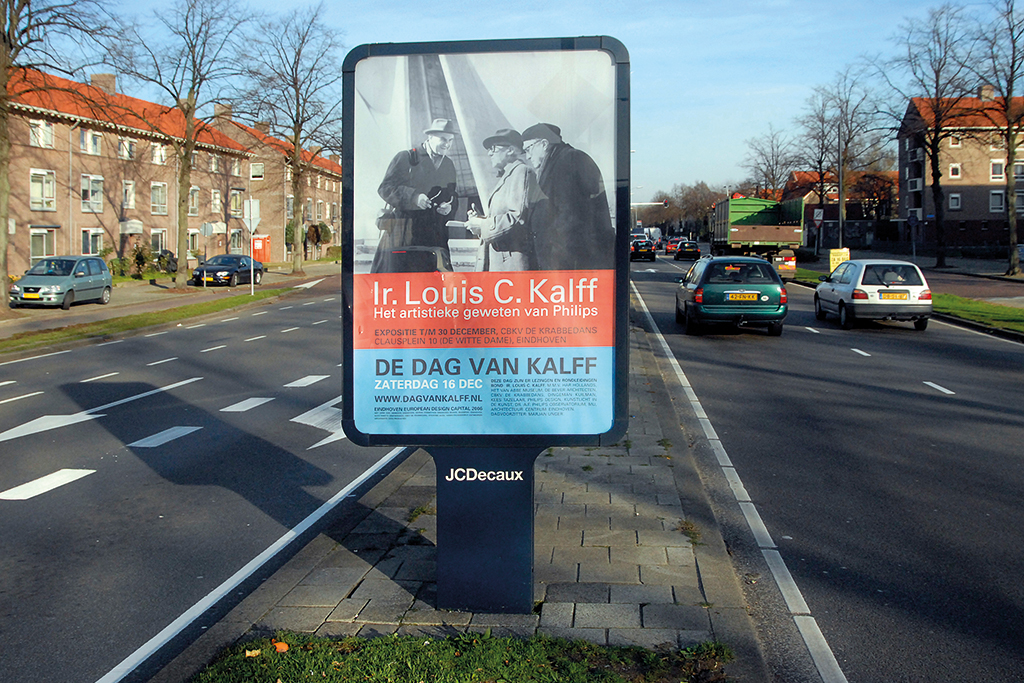
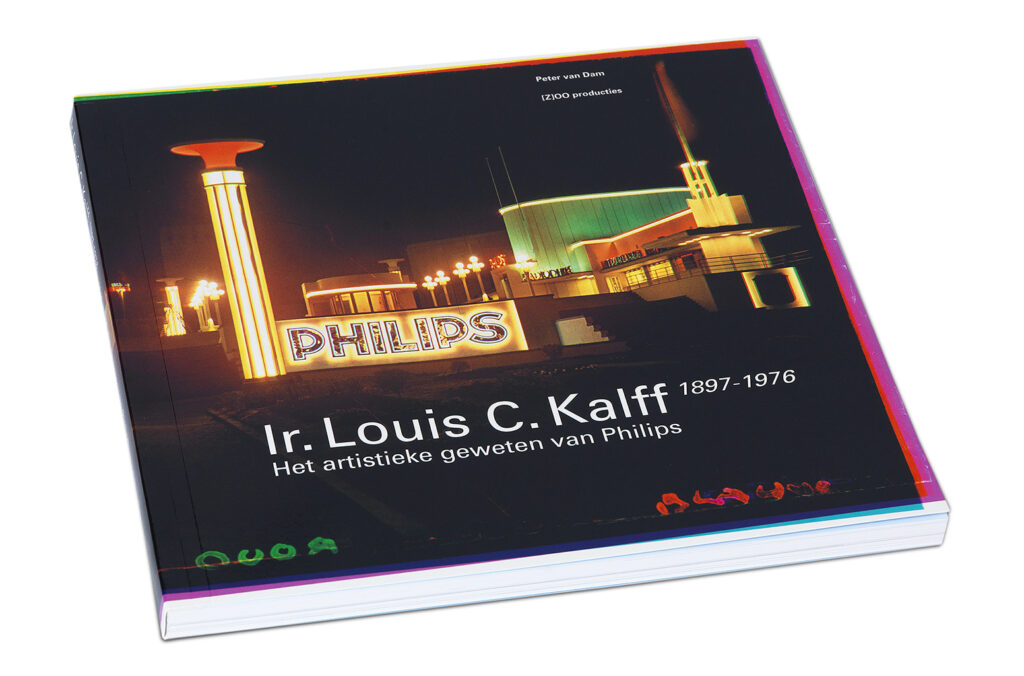
De Dag van Kalff
Eindhoven, December 16, 2006
Lectures, speeches, walks dedicated to Ir. Louis C. Kalff.
With Har Hollands, Van Abbemuseum, De Bever architecten, CBKV de Krabbedans, Dingeman Kuilman, Kees Tazelaar, Philips Design, Kunstlicht in de Kunst, dr. A.F. Philips Sterrenwacht, MU and Architectuur Centrum Eindhoven. Chairman of the day: Marjan Unger.
Hugo Brouwer 100
In the summer of 2011, Robert and Juultje while camping with their children in France met Bart Brouwer, a son of the Eindhoven artist Hugo Brouwer whose public art can be found all over the Eindhoven region. They decided that Hugo Brouwer’s artistic life and creations deserved a book. In the book’s preface, Robert wrote: “I got itchy. I smelled a book. Everything I was interested in could come together: history, art and culture, Eindhoven. It was a story we almost lost the memory of.” Together with the book publication, Eindhovens Dagblad (the city’s daily newspaper) published a series of articles; an exhibition was organized; and on the commemoration day of Hugo Brouwer’s 100th anniversary one could join a bus tour along many of his creations. The publication of this book was made possible by the support of many, including Roto Smeets, Peter Louis Vrijdag, of Vrijdag printers, and co-organizer José Vermey.
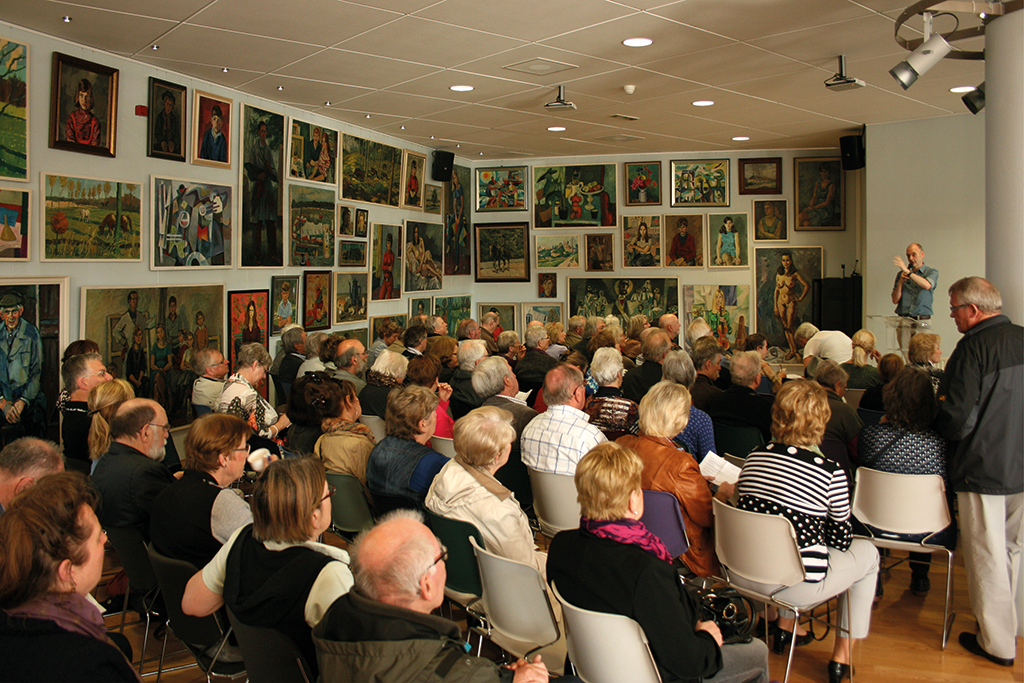
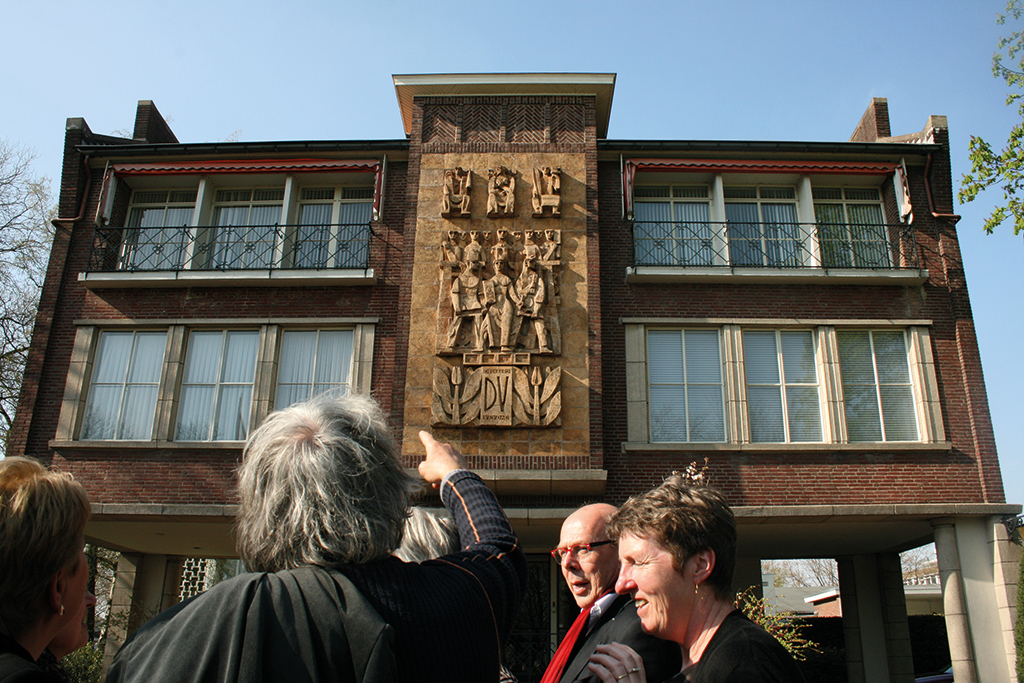
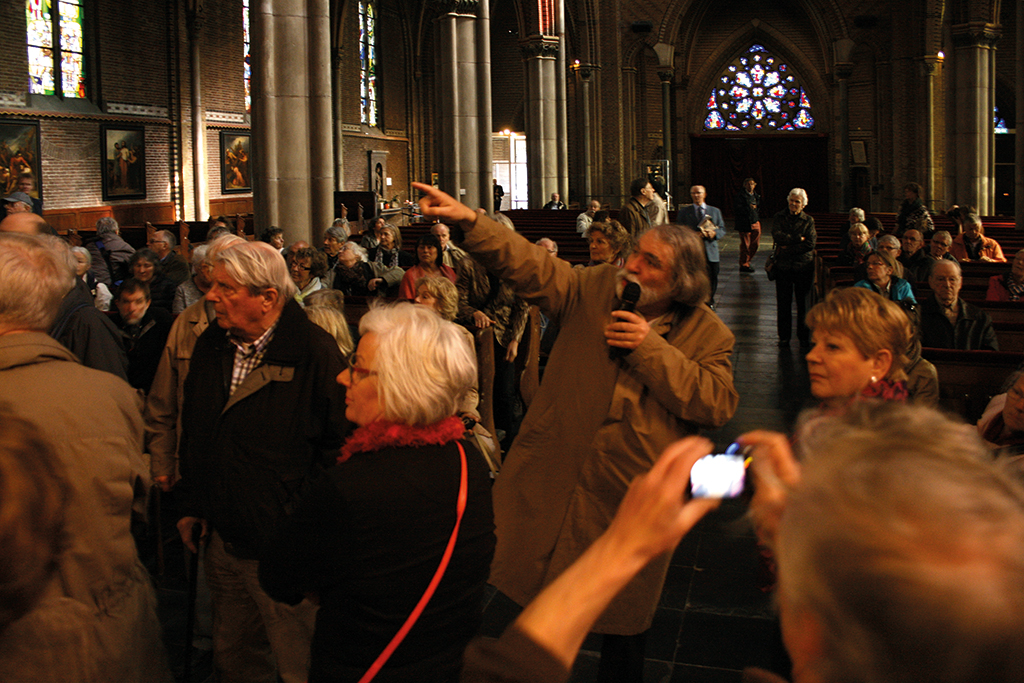
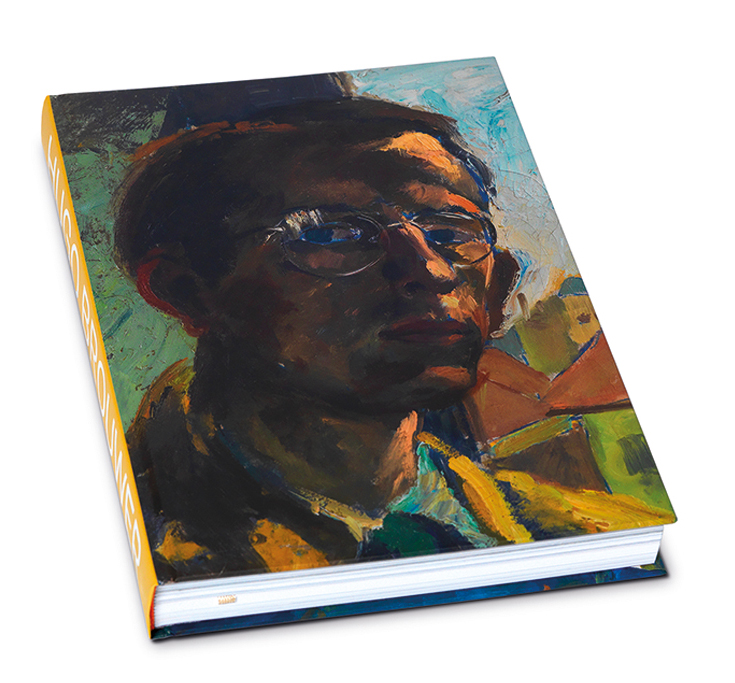
Hugo Brouwer 100
Exhibition, book presentation, bus tour
Regionaal Historisch Centrum Eindhoven
On April 24, 2013, the 100th birthday of Hugo Brouwer, a bus tour took place along a large number of locations where Hugo Brouwer’s work is still being exhibited, including the Catharinakerk and Vrijdag printing works in Eindhoven, the Fatima Church in Weert and his former home in Nuenen.
Heritage
Robert, as a board member of Nederlands Archief Grafische Ontwerpen NAGO (Dutch archives of graphic design, now Wim Crouwel Institute), was always very concerned and involved with the conservation and the permanent accessibility of the archives of designers and design studios. NAGO was dedicated to the collections of graphic designers and illustrators. Robert, in collaboration with the regional Historic Center Eindhoven, took the initiative to establish the Louis Kalff Institute, a national heritage center for industrial design, which started its activities in 2011.
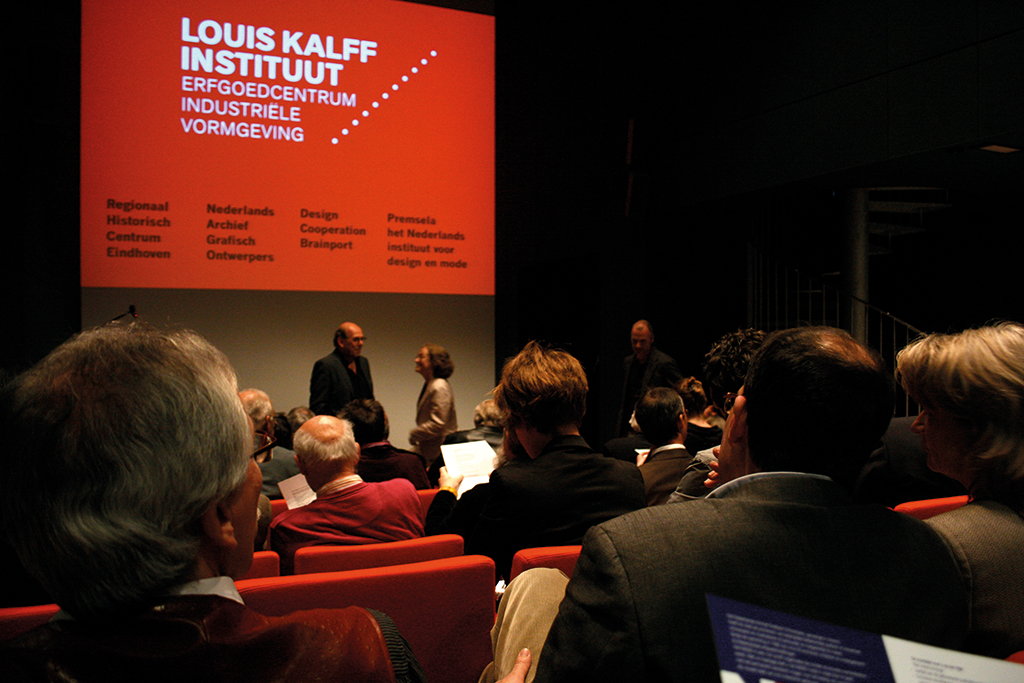
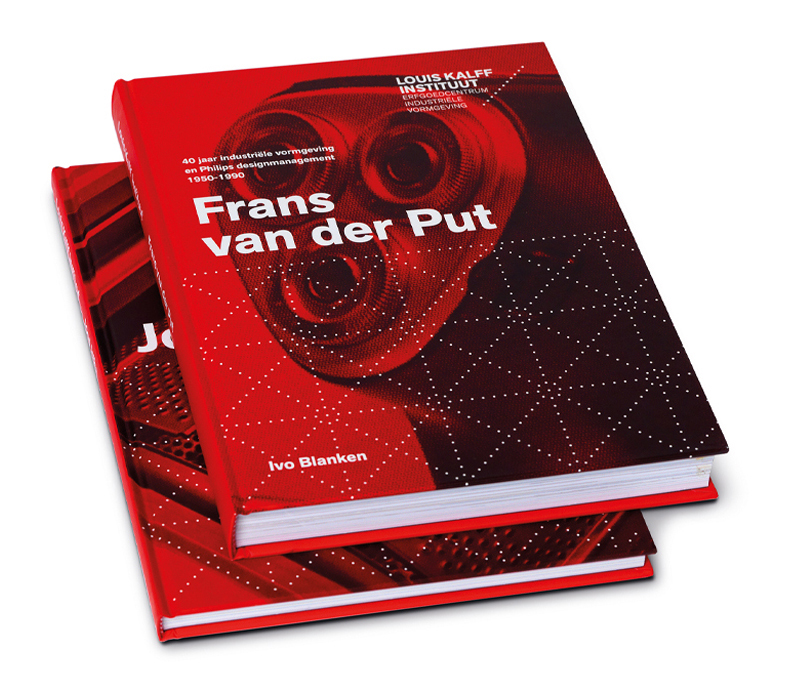
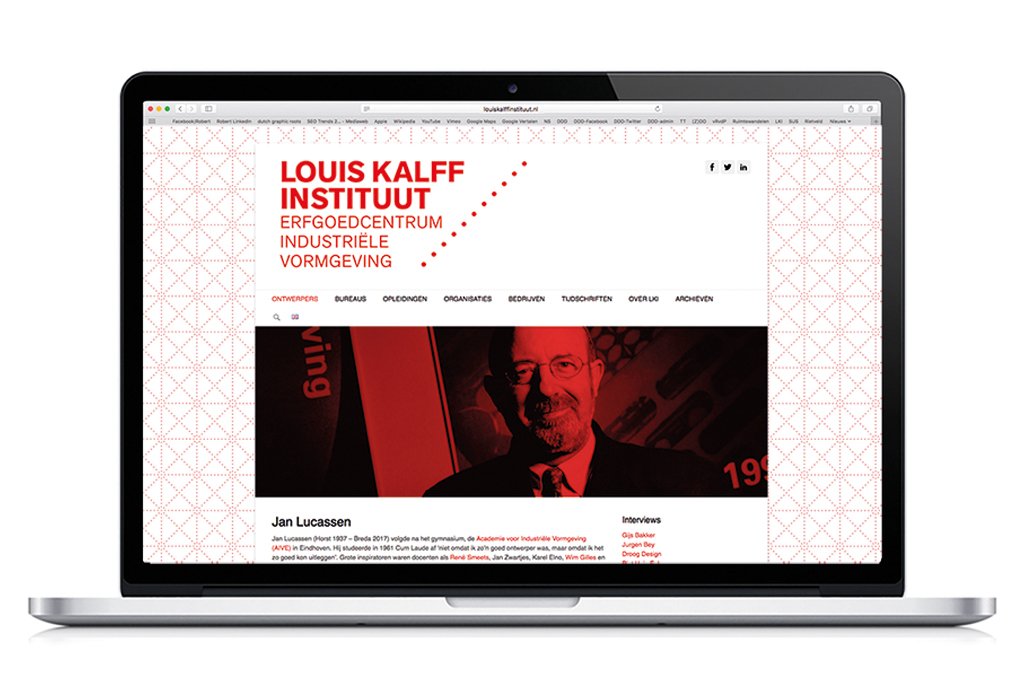
Louis Kalff Instituut
Erfgoedcentrum Industriële Vormgeving Eindhoven
Opening on April 15, 2011 in Van Abbemuseum
First board: Marcel Duijghuisen, Robert van Rixtel, Marie Christine van der Sman.
www.louiskalffinstituut.nl
Dutch Design Daily
Dutch Design Daily is a recent initiative: every day, a news item about Dutch design is published on the Internet in Dutch and English. Eric van Casteren and Robert van Rixtel were this daily’s founding fathers; in 2014, they asked Rob Huisman, Eric Hesen and Titus Yocarini to join them as board members of the foundation Dutch Design Daily. The intention was not just to ask for attention to new developments in Dutch design, but also, by adding 365 items a year, to create a valuable archive. The website is frequently consulted by a large national and international audience. As from 2014, live presentations are organized in Pakhuis De Zwijger, in Amsterdam, of the work of (mostly young) designers that was published on the website. Dutch Design Daily demands a non-stop effort. Its motors are Robert van Rixtel and Juultje van der Put, with the support of hundreds of people from the network they have built over time.
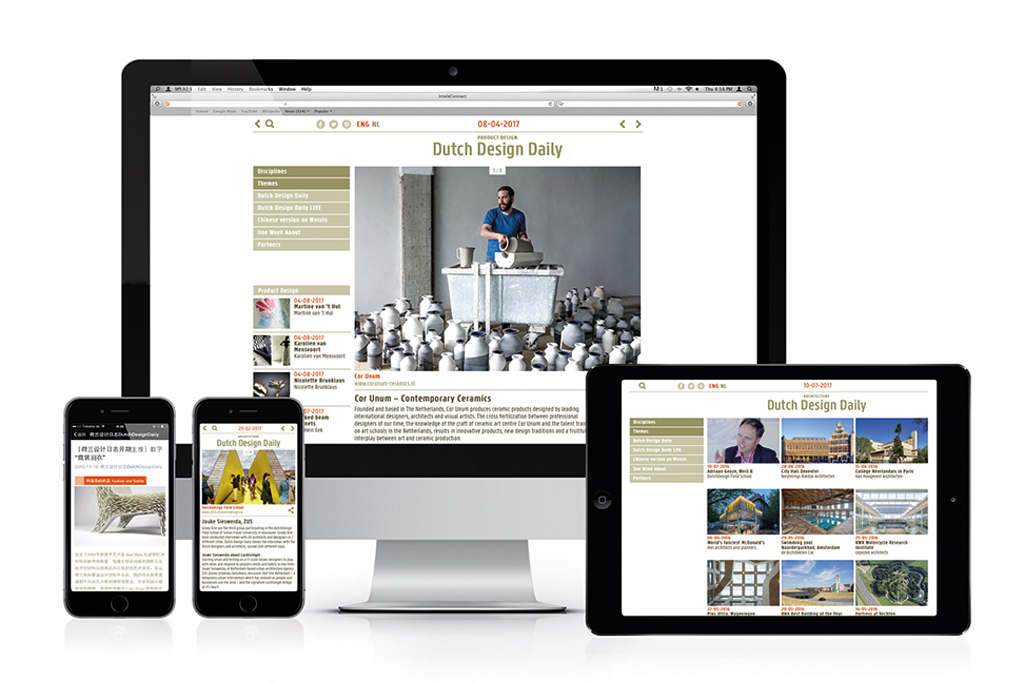
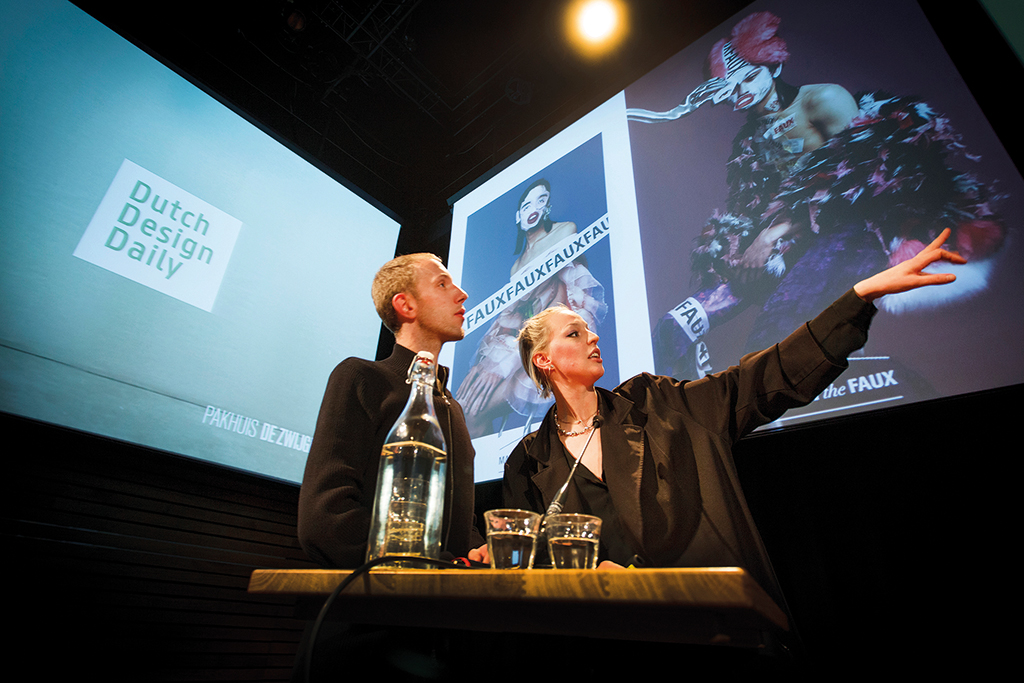
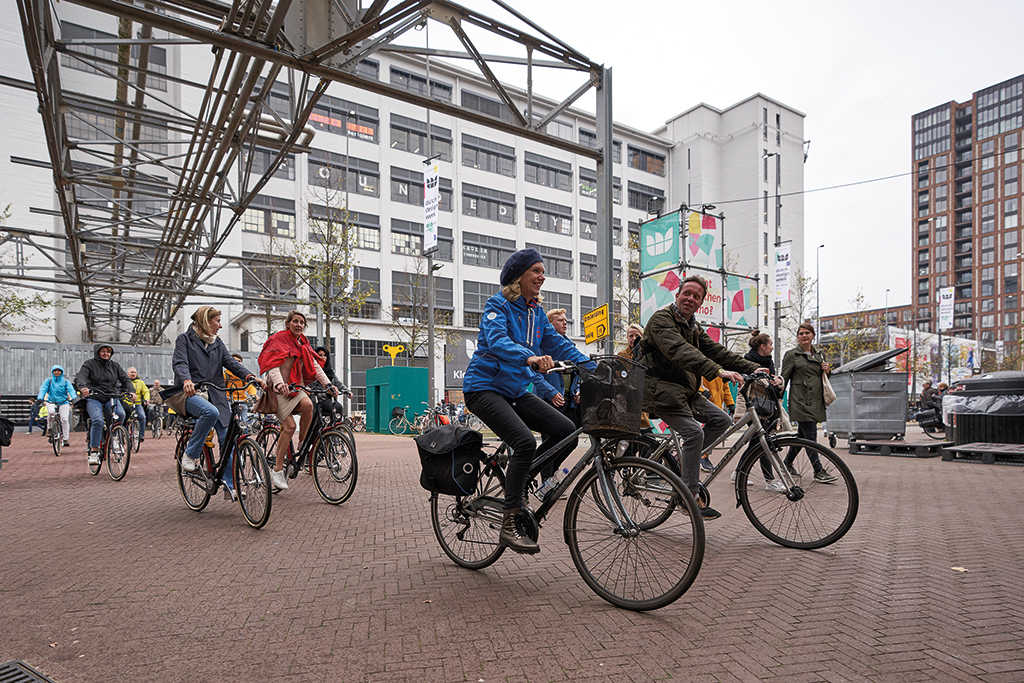
Dutch Design Daily
Online design news in Dutch and English
www.dutchdesigndaily.com
Made by Rietveld
November 12, 2007, Eindhoven
Exhibition in ‘De Bushalte van Rietveld’,
the smallest exhibition space in the Netherlands.
Book launch in Van Abbemuseum.
Group exhibition in Van Abbemuseum.
www.debushaltevanrietveld.nl
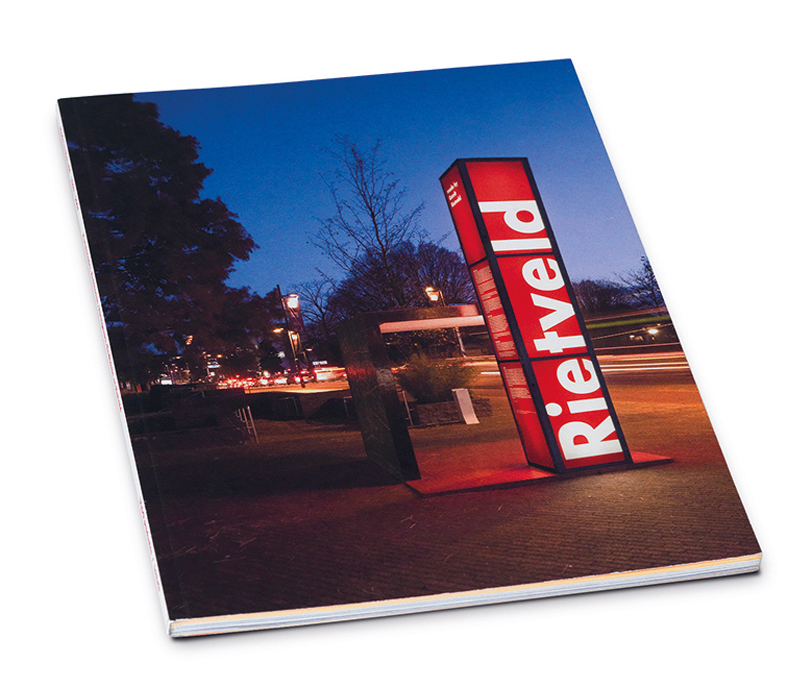
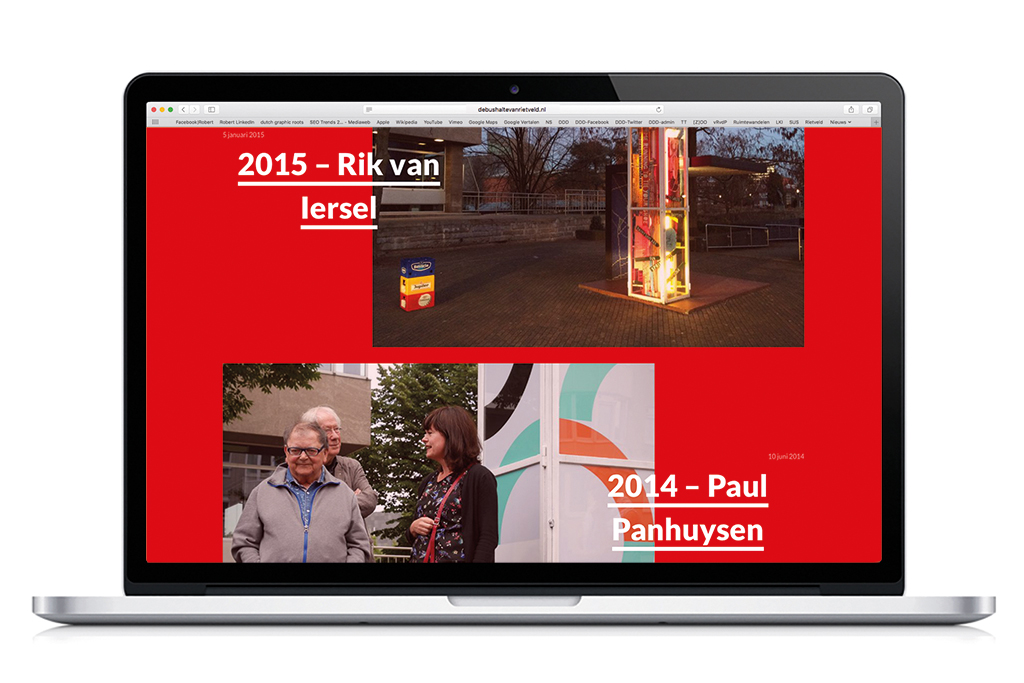
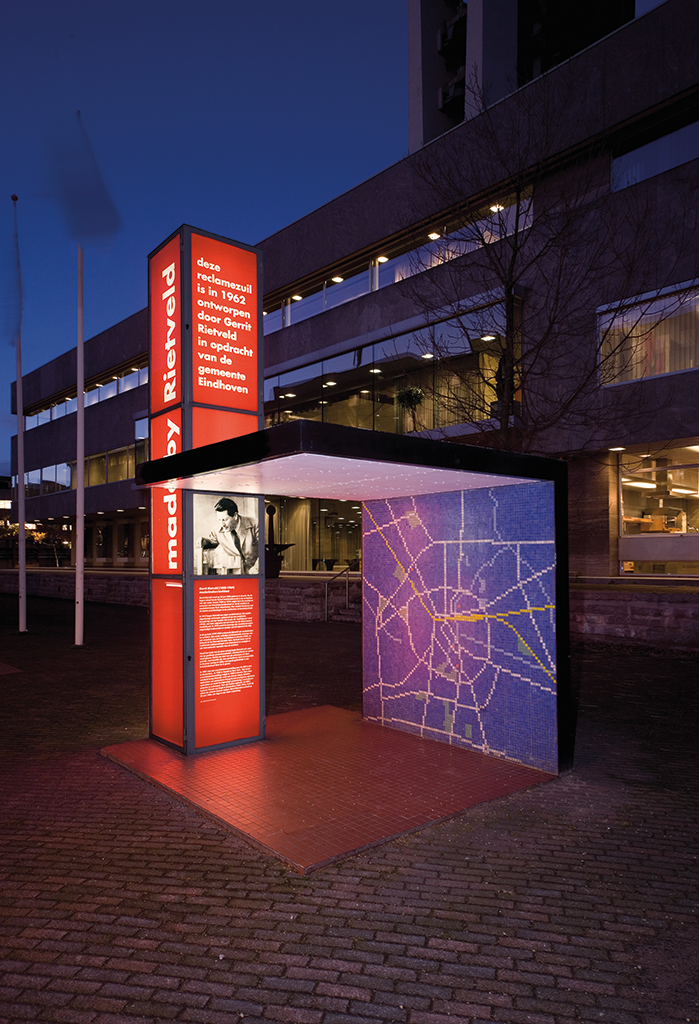
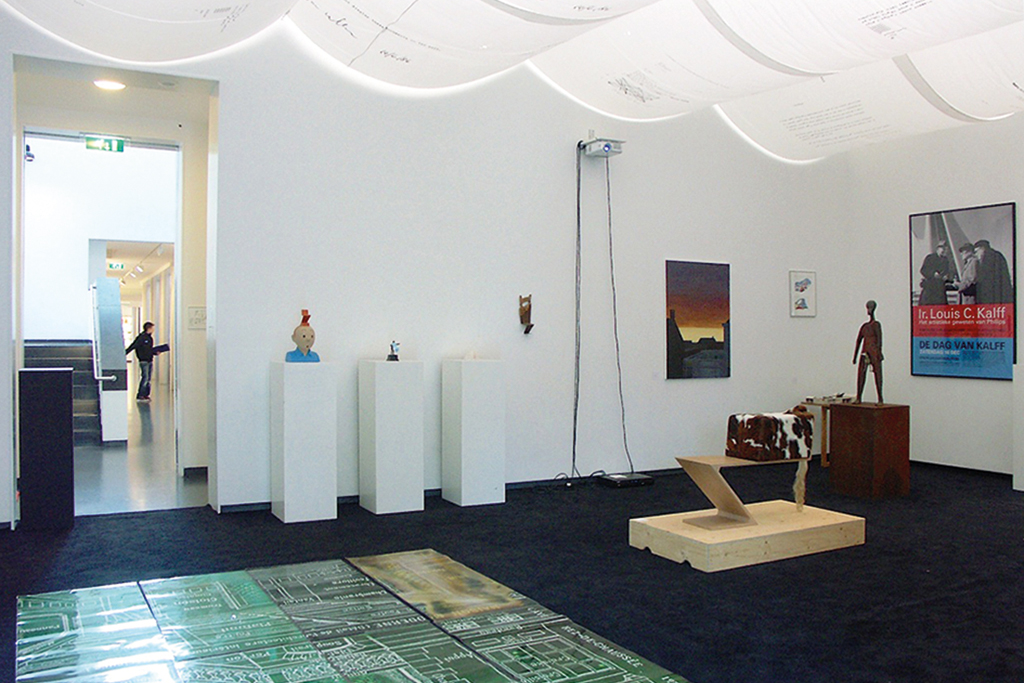
Social Urban Space
Projects on location in Eindhoven during DDW
in collaboration with diederendirrix architects
2009 Lucifer terrein – installation & symposium
2010 Licht in de openbare ruimte – symposium
2011 Licht over de Dommel – group project
2012 Verweesde Viaducten – city safari
2013 Kunt en design als publieke zaak – symposium
2016 Van wie is de Straat? – exposition Van Abbemuseum
www.socialurbanspace.nl
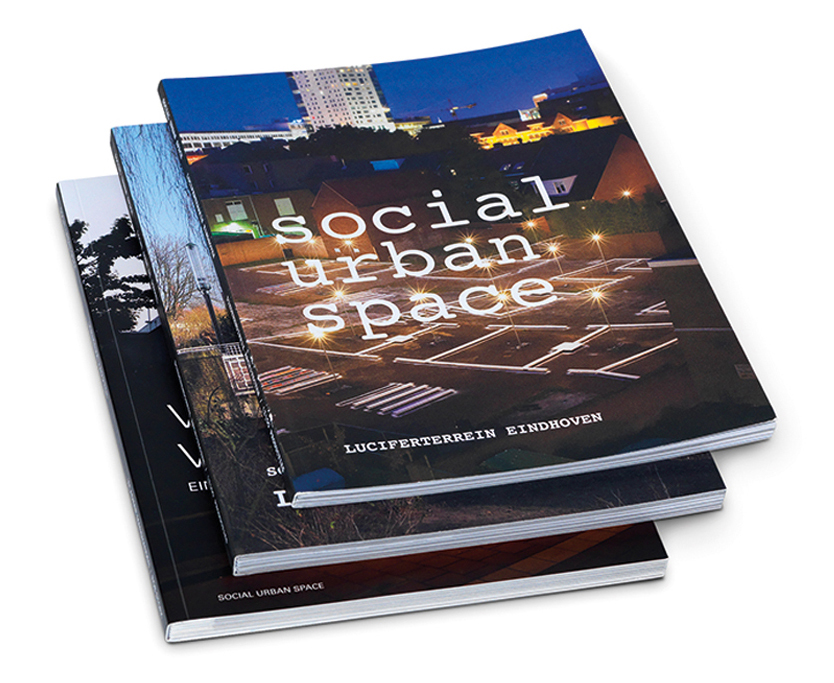
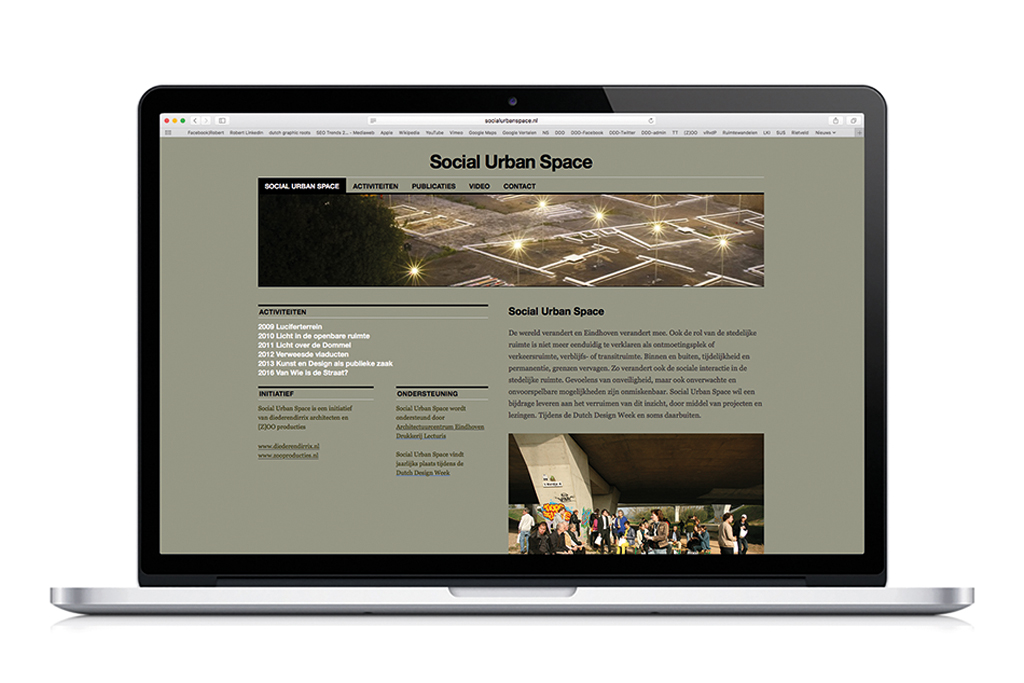
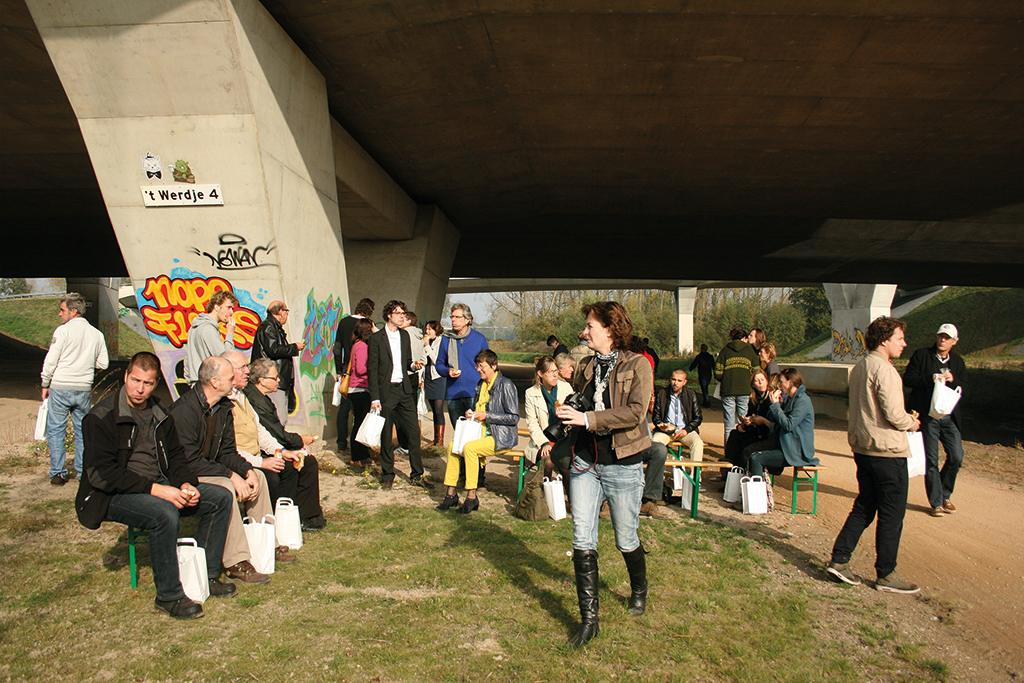
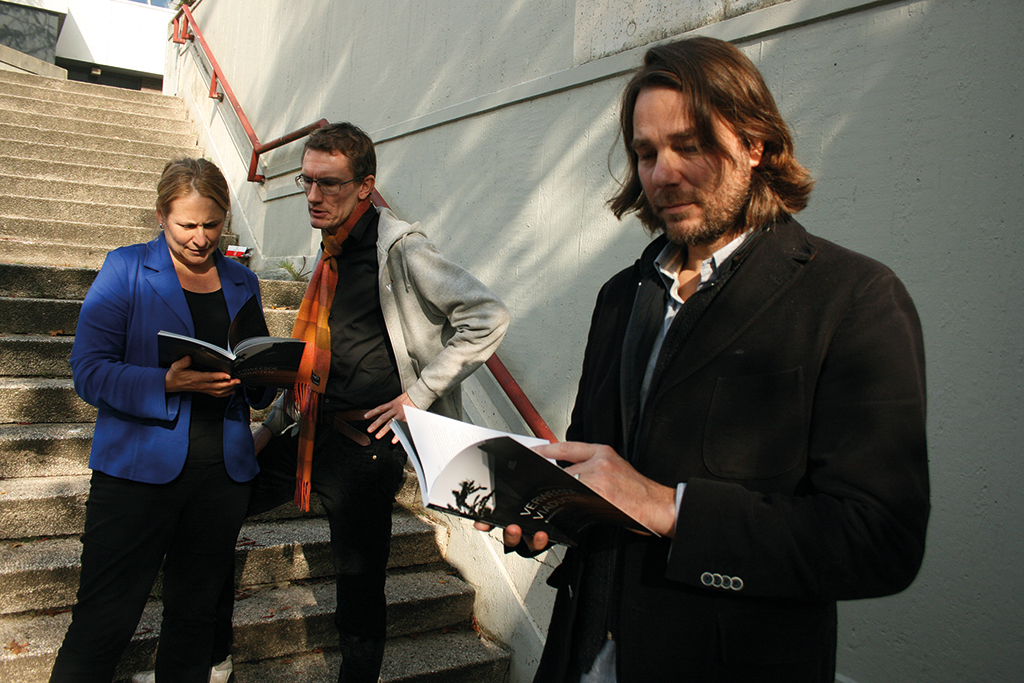
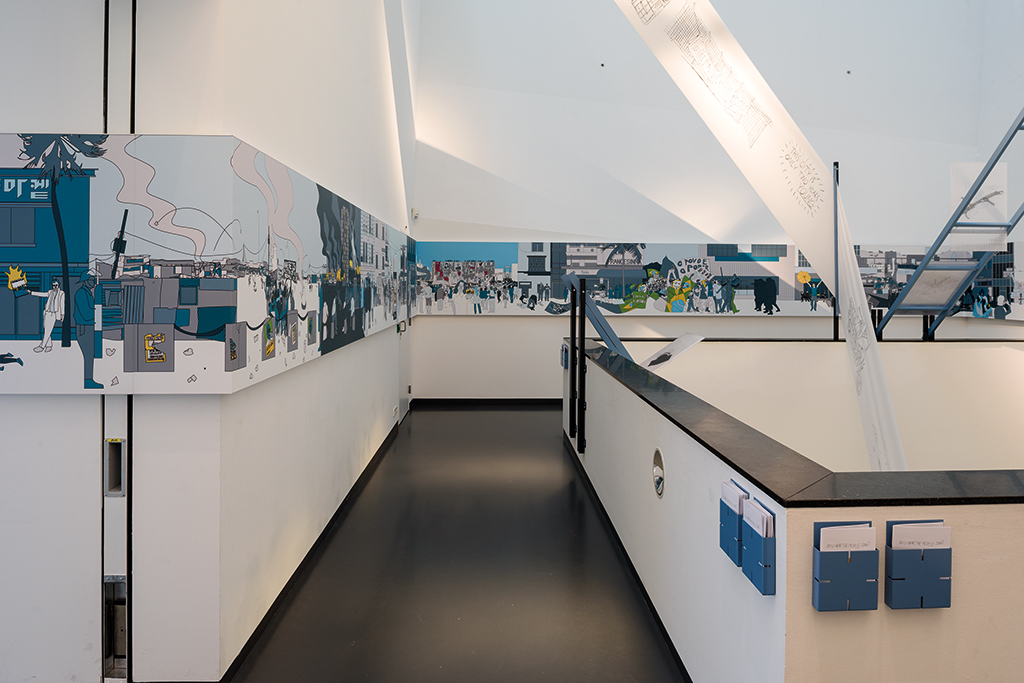
Ben Bos 80
Pakhuis de Zwijger, Amsterdam, September 5, 2010
Celebration of the 80th birthday of Ben Bos
In collaboration with BNO, Premsela, NAGO and Pakhuis de Zwijger.
With Ed Balk, Elly Bonsen, Wim Crouwel, Piet Gerards, Rob Huisman, Joost Klinkenberg, Richard van der Laken, Bas van Lier, Peter van Lindonk, Job Meihuizen, Hugo Puttaert, Victor Sciferli and Titus Yocarini. Chairman of the day: Peter Kersten.
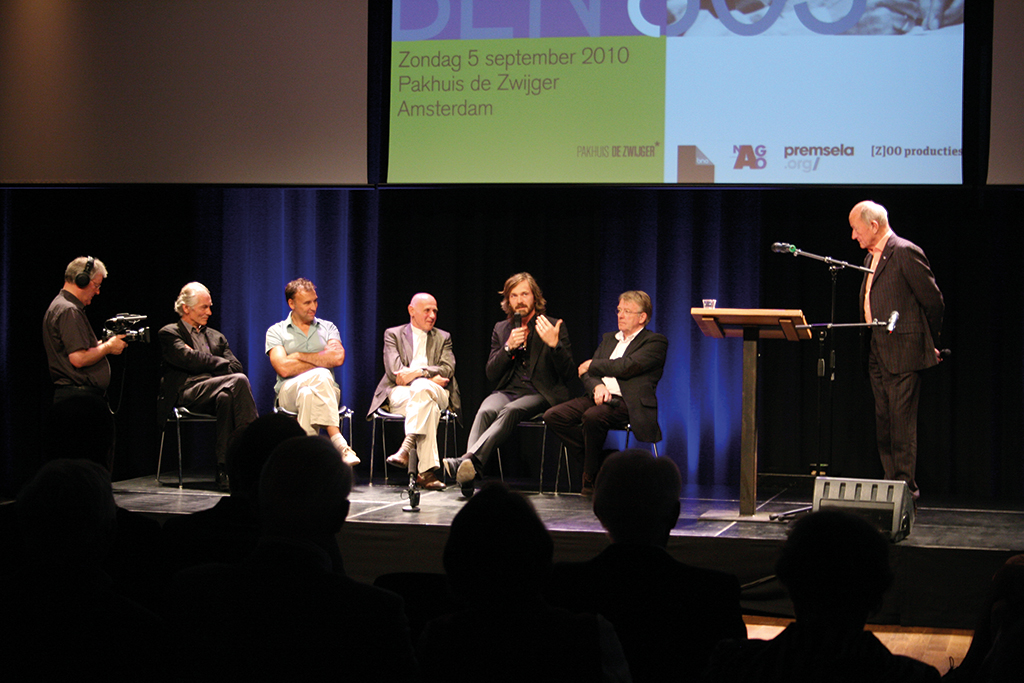
Ruimtewandelen in het Park
Stadswandelpark Eindhoven, September 8, 2013
In collaboration with Suzanne van Gool, Peter Kentie and Manuel Wijfels
Symposium in the Parktheater with André Kuipers and Piet Smolders, and an augmented reality tour in the park to mark 75 years of Sterrenwacht Eindhoven. Armed with a smartphone or tablet, 800 people, young and old, walked through the Eindhoven Stadswandelpark in search of astronauts, rockets, moon landers and planets.
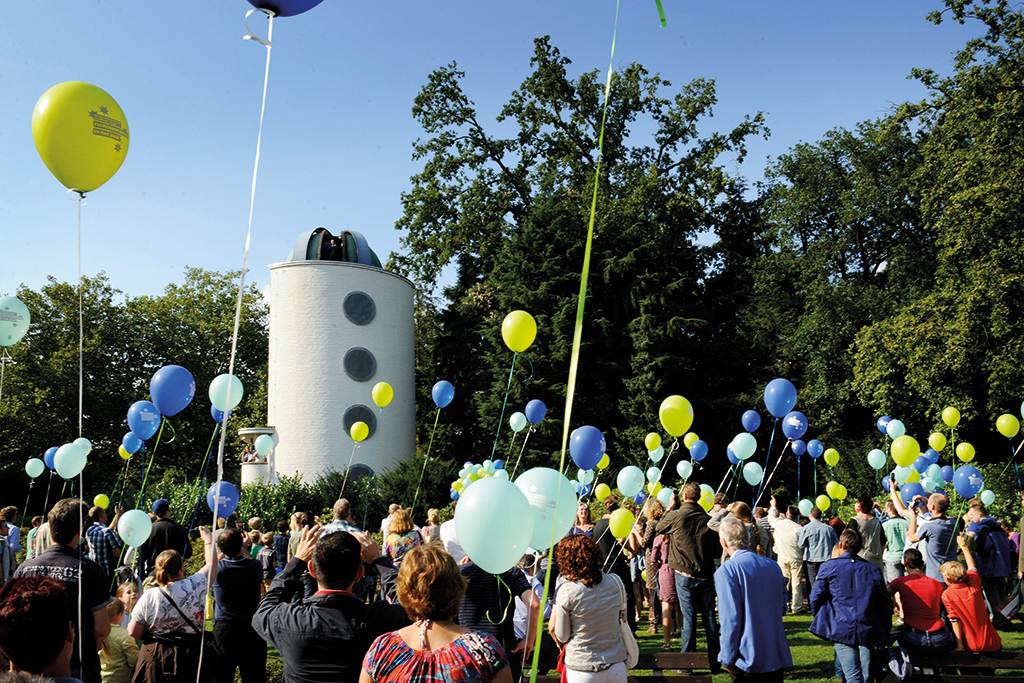
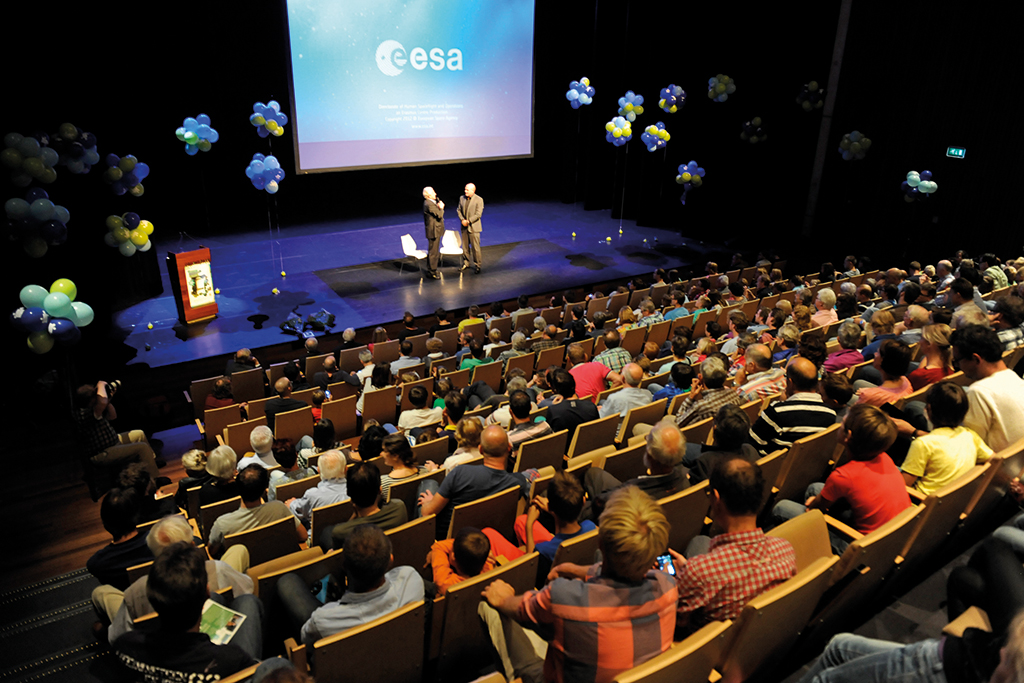
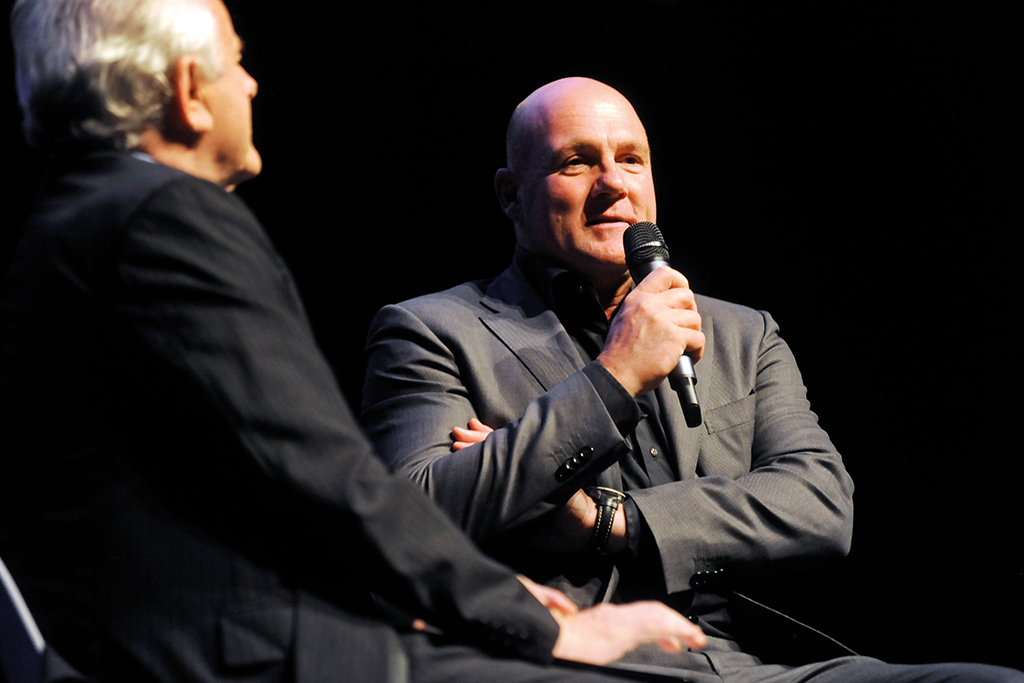
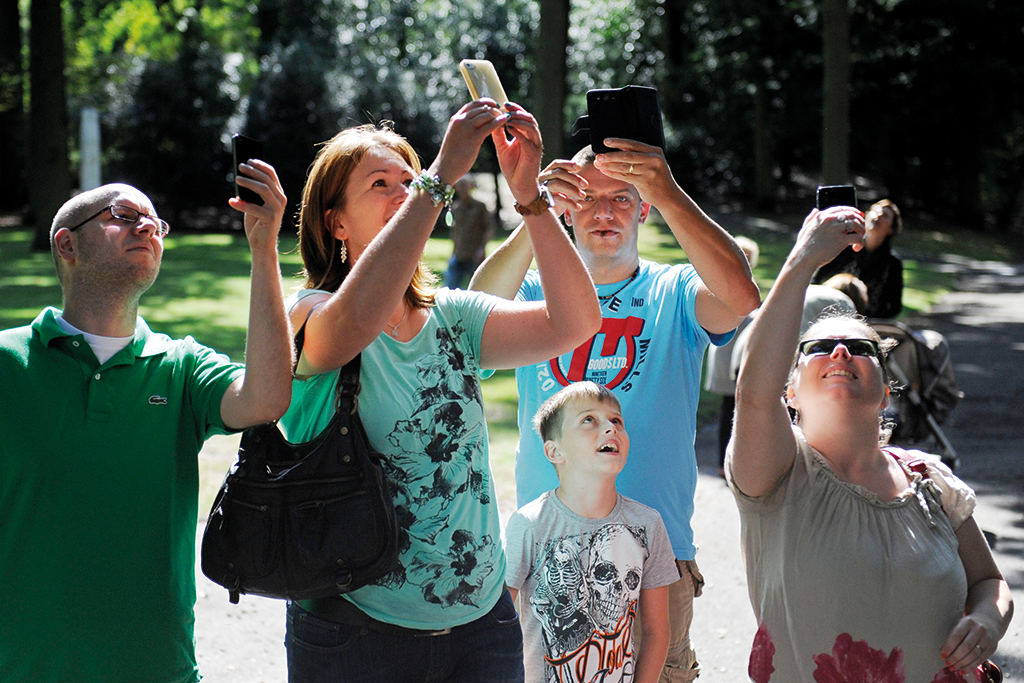
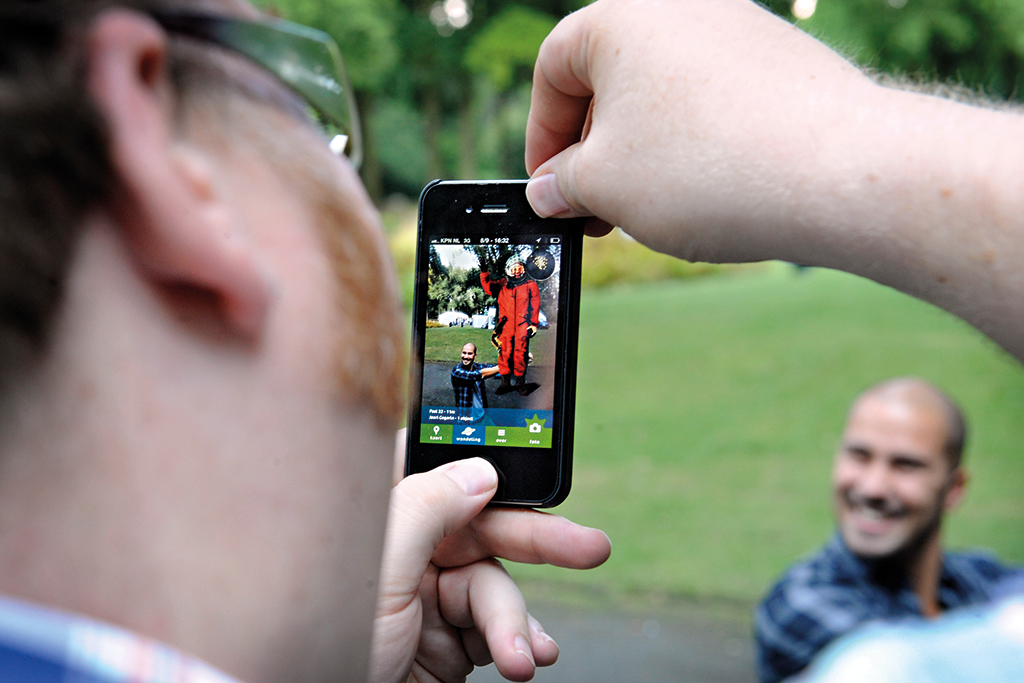
In 2006, Robert van Rixtel and Eric van Casteren received the Grafische Cultuurprijs (graphic culture award) for all their activities. The award ceremony took place in the Beurs van Berlage in Amsterdam. Ron van Roon designed a screen print for the occasion.
Robert became a BNO honorary member in 2011 for his contributions to the design profession.
The archives of [Z]OO producties have been adopted by the Bijzondere Collecties of the University of Amsterdam.
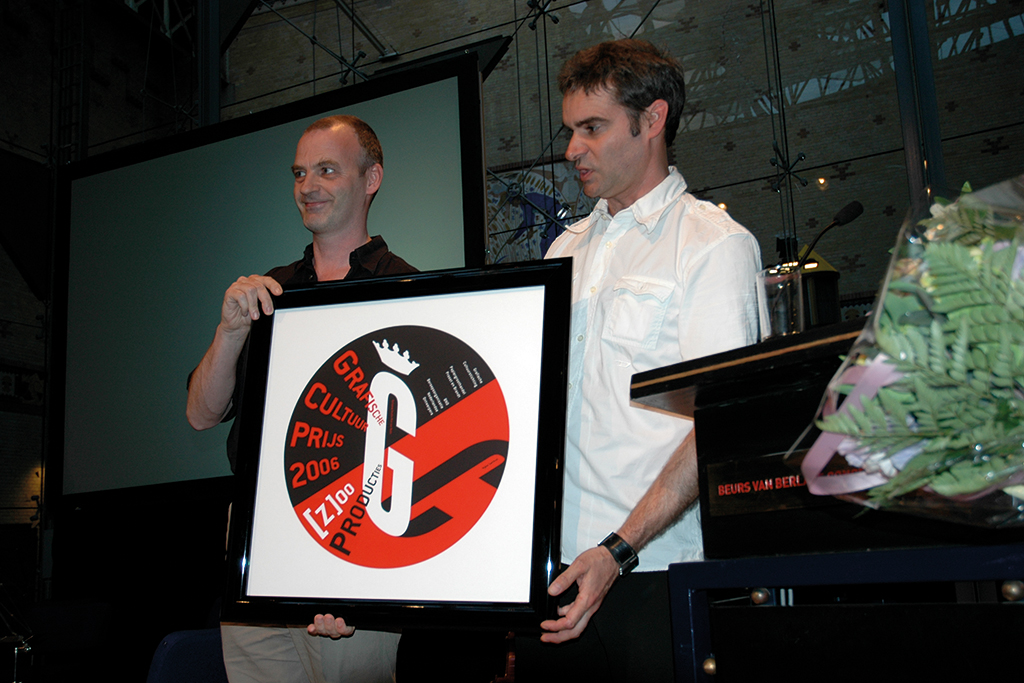
Robert van Rixtel
born on 20 August 1961, Eindhoven
Author of the original text: Titus Yocarini, March 2019
English translation and editing: Ton Haak
Final editing: Sybrand Zijlstra
Portrait photo: Aatjan Renders
